Business Analysis Report for Learning Management
VerifiedAdded on 2020/02/24
|55
|11267
|46
AI Summary
This document presents a detailed Business Analysis Report for the development of a Learning Management System. It comprehensively analyzes both functional and non-functional requirements, defining user roles, system functionalities, and performance expectations. The report includes stakeholder analysis, use case diagrams, data flow diagrams, and a thorough examination of business processes related to the proposed learning management system.
Contribute Materials
Your contribution can guide someone’s learning journey. Share your
documents today.
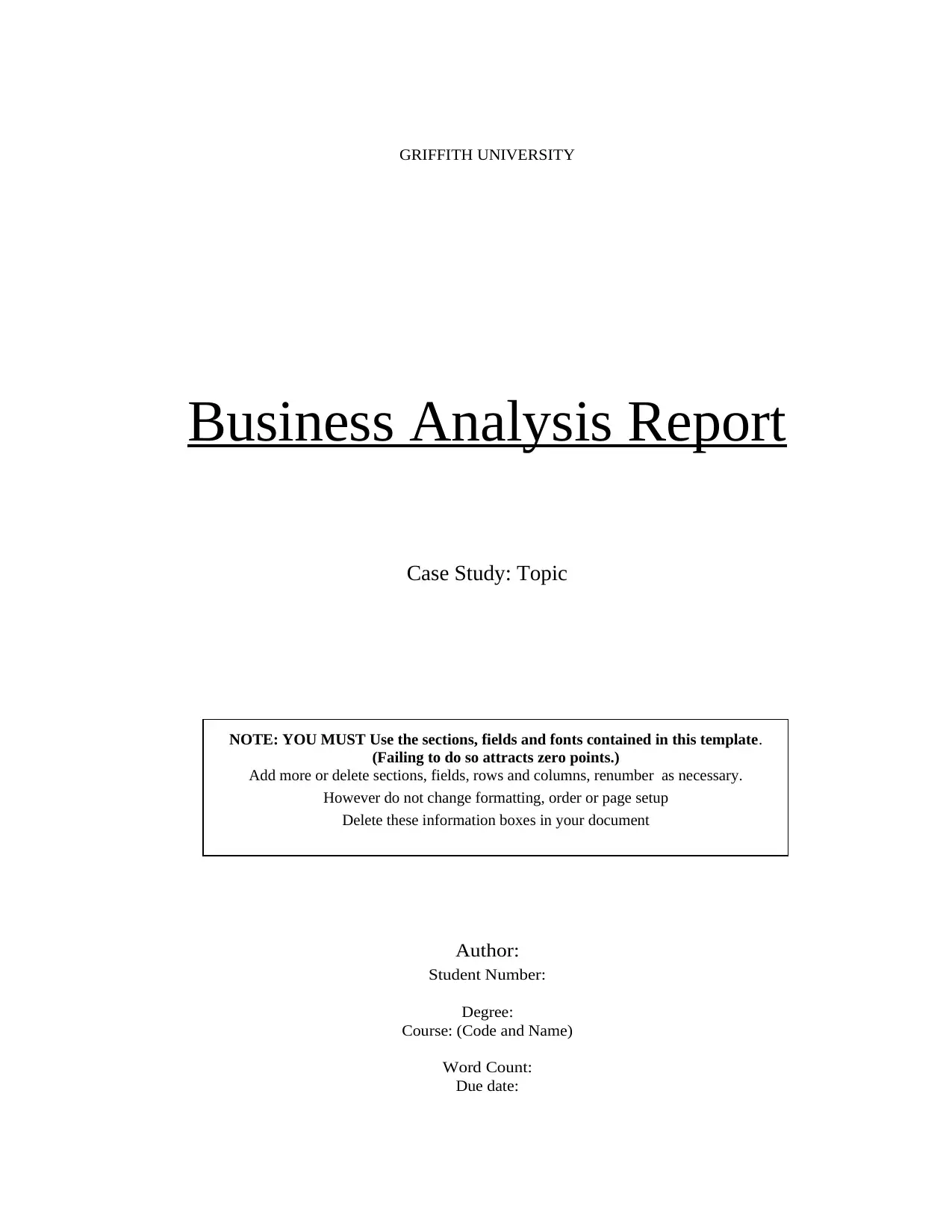
GRIFFITH UNIVERSITY
Business Analysis Report
Case Study: Topic
Author:
Student Number:
Degree:
Course: (Code and Name)
Word Count:
Due date:
NOTE: YOU MUST Use the sections, fields and fonts contained in this template.
(Failing to do so attracts zero points.)
Add more or delete sections, fields, rows and columns, renumber as necessary.
However do not change formatting, order or page setup
Delete these information boxes in your document
Business Analysis Report
Case Study: Topic
Author:
Student Number:
Degree:
Course: (Code and Name)
Word Count:
Due date:
NOTE: YOU MUST Use the sections, fields and fonts contained in this template.
(Failing to do so attracts zero points.)
Add more or delete sections, fields, rows and columns, renumber as necessary.
However do not change formatting, order or page setup
Delete these information boxes in your document
Secure Best Marks with AI Grader
Need help grading? Try our AI Grader for instant feedback on your assignments.

Client Name
Address 1 (Number / Unit Street)
Address 2 (Suburb State Code)
Dear Title and Client Name ,
“A cover letter, covering letter, motivation letter, motivational letter or a letter of motivation is a
letter of introduction attached to, or accompanying another document.” (Wikipedia)
Describe why you are contacting the recipient
Describe very briefly what you have accomplished, what is attached etc.
See e.g. http://www.melbourneresumes.com.au/cover-letters/cover-letter-examples/ for cover letter
samples.
Please do not hesitate to contact me should you require any clarifications or additional information.
Thank you for your time and consideration.
Kind / Best Regards,
Author Name
dd/mm/yyyy
Address 1 (Number / Unit Street)
Address 2 (Suburb State Code)
Dear Title and Client Name ,
“A cover letter, covering letter, motivation letter, motivational letter or a letter of motivation is a
letter of introduction attached to, or accompanying another document.” (Wikipedia)
Describe why you are contacting the recipient
Describe very briefly what you have accomplished, what is attached etc.
See e.g. http://www.melbourneresumes.com.au/cover-letters/cover-letter-examples/ for cover letter
samples.
Please do not hesitate to contact me should you require any clarifications or additional information.
Thank you for your time and consideration.
Kind / Best Regards,
Author Name
dd/mm/yyyy

Page 1 of 52
Business Analysis
Report
Author
Executive Summary
The topic was concerned with the identification of issues related to the
Human activity system used for the learning management at Griffith University.
The various stakeholders have been identified along with the management of
various business activities to resolve the kind of issue faced. The need for
implementing an effective IT system has been fulfilled and the various study
materials have been accesses by the students with the help of new online student
portal made available for them,. The flexible options available along with the
enhancement of quality of higher educations services have further helped in
attracting more students and retained the existing ones too.
Business Analysis
Report
Author
Executive Summary
The topic was concerned with the identification of issues related to the
Human activity system used for the learning management at Griffith University.
The various stakeholders have been identified along with the management of
various business activities to resolve the kind of issue faced. The need for
implementing an effective IT system has been fulfilled and the various study
materials have been accesses by the students with the help of new online student
portal made available for them,. The flexible options available along with the
enhancement of quality of higher educations services have further helped in
attracting more students and retained the existing ones too.

Page 2 of 52
Business Analysis
Report
Author
Table of Contents
1. Introduction.....................................................................................................4
2. Identification of Business Problem and Need..............................................4
2.1. Business Problem/s and Need/s.........................................................5
2.2. Business Goals & Objectives........................................................10
2.3. Desired Outcome/s.........................................................................11
3. Stakeholder Analysis....................................................................................13
3.1. Stakeholder List...............................................................................13
Stakeholder Roles & Responsibilities.....................................................13
3.2. Attitude & Influence........................................................................14
3.3. Stakeholder Relationships and Mapping......................................15
4. Approach to Req’s Life Cycle Management...........................................16
5. Change Strategy, Value, Recommended Solution........................................19
5.1 Solution Scope...............................................................................19
5.1. Potential Benefits...........................................................................22
5.2. Risk Assessment............................................................................23
6. Requirements Analysis................................................................................24
6.1. Business Requirements..................................................................24
Business Analysis
Report
Author
Table of Contents
1. Introduction.....................................................................................................4
2. Identification of Business Problem and Need..............................................4
2.1. Business Problem/s and Need/s.........................................................5
2.2. Business Goals & Objectives........................................................10
2.3. Desired Outcome/s.........................................................................11
3. Stakeholder Analysis....................................................................................13
3.1. Stakeholder List...............................................................................13
Stakeholder Roles & Responsibilities.....................................................13
3.2. Attitude & Influence........................................................................14
3.3. Stakeholder Relationships and Mapping......................................15
4. Approach to Req’s Life Cycle Management...........................................16
5. Change Strategy, Value, Recommended Solution........................................19
5.1 Solution Scope...............................................................................19
5.1. Potential Benefits...........................................................................22
5.2. Risk Assessment............................................................................23
6. Requirements Analysis................................................................................24
6.1. Business Requirements..................................................................24
Secure Best Marks with AI Grader
Need help grading? Try our AI Grader for instant feedback on your assignments.
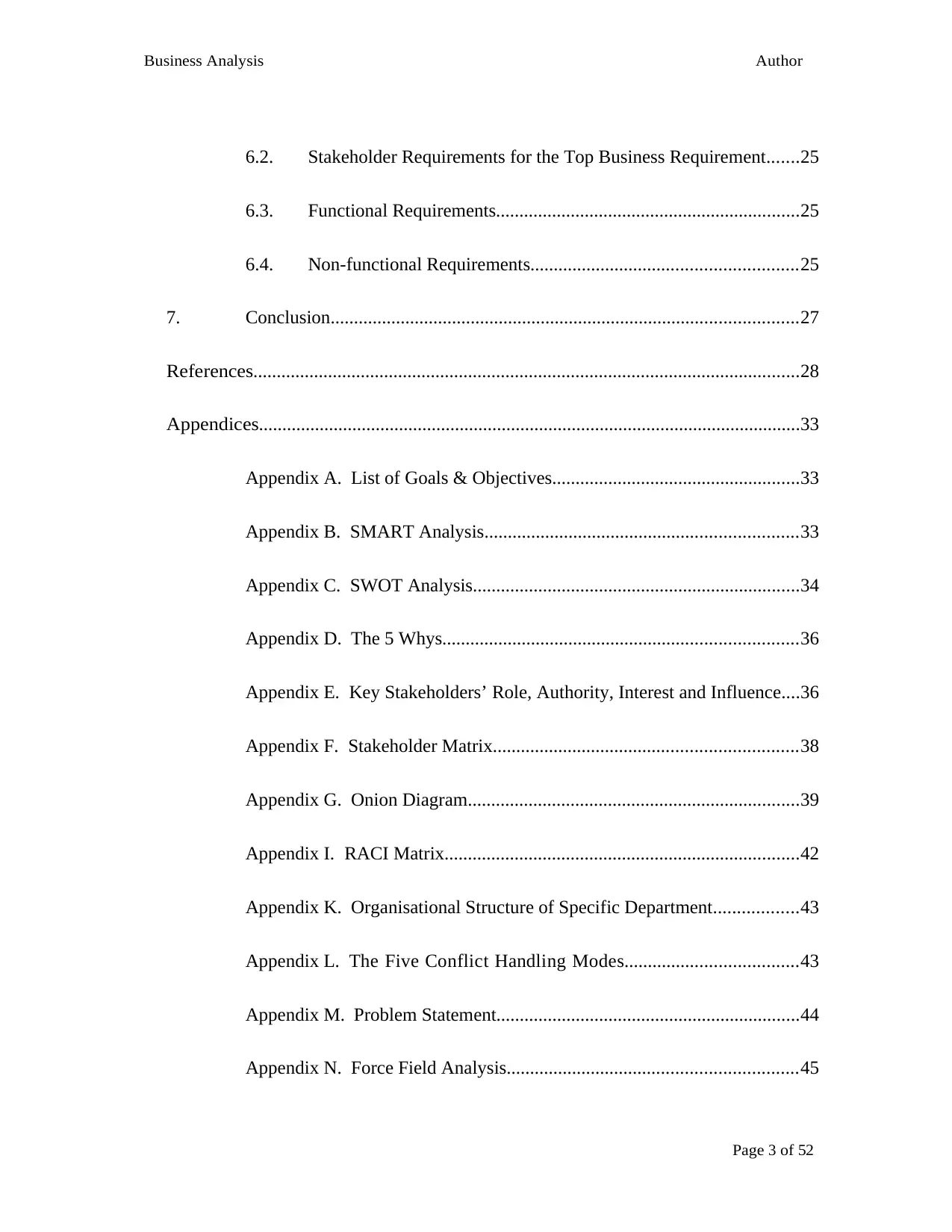
Page 3 of 52
Business Analysis
Report
Author
6.2. Stakeholder Requirements for the Top Business Requirement.......25
6.3. Functional Requirements.................................................................25
6.4. Non-functional Requirements.........................................................25
7. Conclusion....................................................................................................27
References.....................................................................................................................28
Appendices....................................................................................................................33
Appendix A. List of Goals & Objectives.....................................................33
Appendix B. SMART Analysis...................................................................33
Appendix C. SWOT Analysis......................................................................34
Appendix D. The 5 Whys............................................................................36
Appendix E. Key Stakeholders’ Role, Authority, Interest and Influence....36
Appendix F. Stakeholder Matrix.................................................................38
Appendix G. Onion Diagram.......................................................................39
Appendix I. RACI Matrix............................................................................42
Appendix K. Organisational Structure of Specific Department..................43
Appendix L. The Five Conflict Handling Modes.....................................43
Appendix M. Problem Statement.................................................................44
Appendix N. Force Field Analysis..............................................................45
Business Analysis
Report
Author
6.2. Stakeholder Requirements for the Top Business Requirement.......25
6.3. Functional Requirements.................................................................25
6.4. Non-functional Requirements.........................................................25
7. Conclusion....................................................................................................27
References.....................................................................................................................28
Appendices....................................................................................................................33
Appendix A. List of Goals & Objectives.....................................................33
Appendix B. SMART Analysis...................................................................33
Appendix C. SWOT Analysis......................................................................34
Appendix D. The 5 Whys............................................................................36
Appendix E. Key Stakeholders’ Role, Authority, Interest and Influence....36
Appendix F. Stakeholder Matrix.................................................................38
Appendix G. Onion Diagram.......................................................................39
Appendix I. RACI Matrix............................................................................42
Appendix K. Organisational Structure of Specific Department..................43
Appendix L. The Five Conflict Handling Modes.....................................43
Appendix M. Problem Statement.................................................................44
Appendix N. Force Field Analysis..............................................................45

Page 4 of 52
Business Analysis
Report
Author
Appendix O. Decision Tree Analysis..........................................................46
Appendix P. Potential Benefits Table..........................................................46
Appendix Q. Risk Assessment Table..........................................................47
Appendix R. MoSCoW Analysis.................................................................48
Appendix S. Use Case Descriptions............................................................49
Appendix T. The functional attributes of the various events have been
understood with the help of Use case descriptions.......................................49
Appendix U. List of Non-Functional Requirements Analysis.....................50
Business Analysis
Report
Author
Appendix O. Decision Tree Analysis..........................................................46
Appendix P. Potential Benefits Table..........................................................46
Appendix Q. Risk Assessment Table..........................................................47
Appendix R. MoSCoW Analysis.................................................................48
Appendix S. Use Case Descriptions............................................................49
Appendix T. The functional attributes of the various events have been
understood with the help of Use case descriptions.......................................49
Appendix U. List of Non-Functional Requirements Analysis.....................50
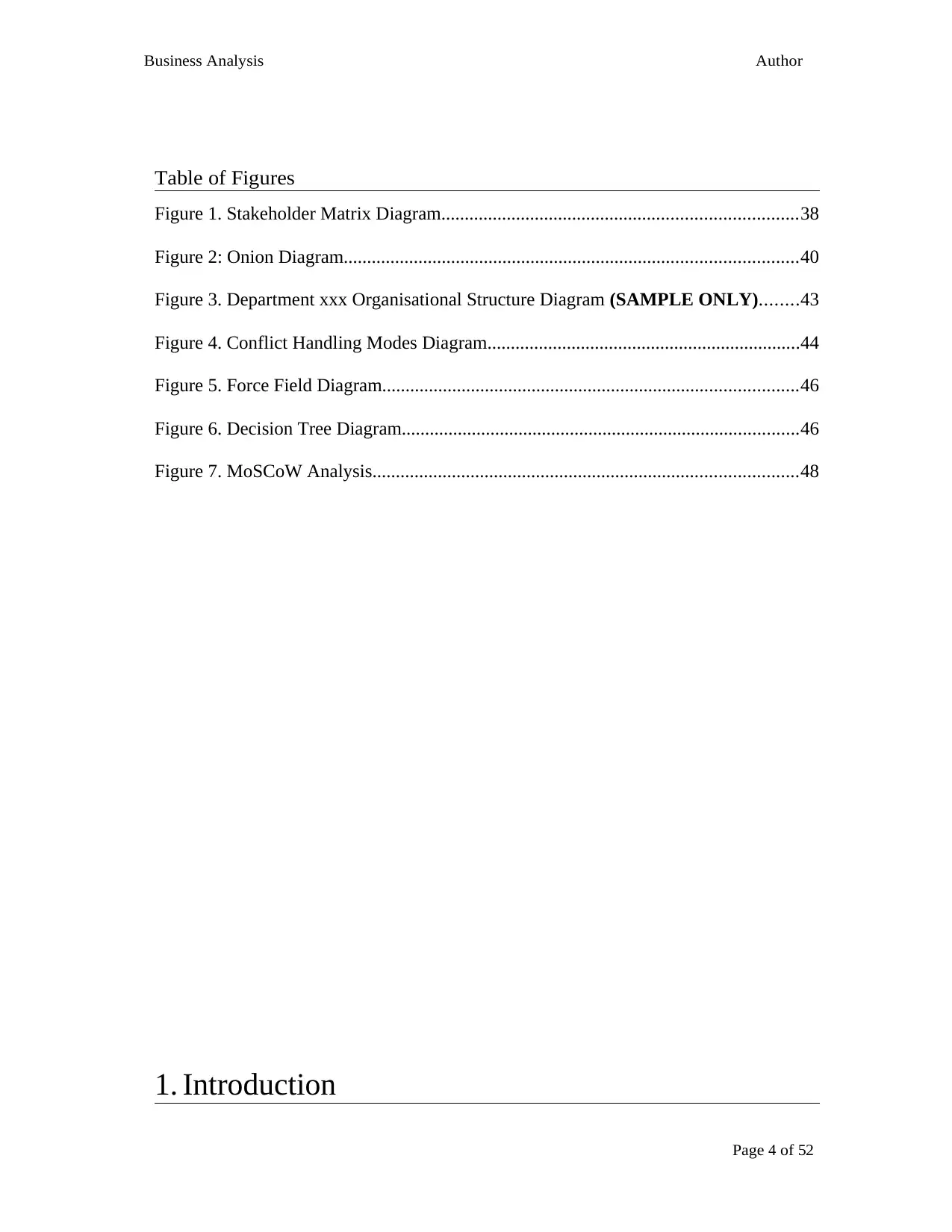
Page 4 of 52
Business Analysis
Report
Author
Table of Figures
Figure 1. Stakeholder Matrix Diagram............................................................................38
Figure 2: Onion Diagram.................................................................................................40
Figure 3. Department xxx Organisational Structure Diagram (SAMPLE ONLY)........43
Figure 4. Conflict Handling Modes Diagram...................................................................44
Figure 5. Force Field Diagram.........................................................................................46
Figure 6. Decision Tree Diagram.....................................................................................46
Figure 7. MoSCoW Analysis...........................................................................................48
1. Introduction
Business Analysis
Report
Author
Table of Figures
Figure 1. Stakeholder Matrix Diagram............................................................................38
Figure 2: Onion Diagram.................................................................................................40
Figure 3. Department xxx Organisational Structure Diagram (SAMPLE ONLY)........43
Figure 4. Conflict Handling Modes Diagram...................................................................44
Figure 5. Force Field Diagram.........................................................................................46
Figure 6. Decision Tree Diagram.....................................................................................46
Figure 7. MoSCoW Analysis...........................................................................................48
1. Introduction
Paraphrase This Document
Need a fresh take? Get an instant paraphrase of this document with our AI Paraphraser
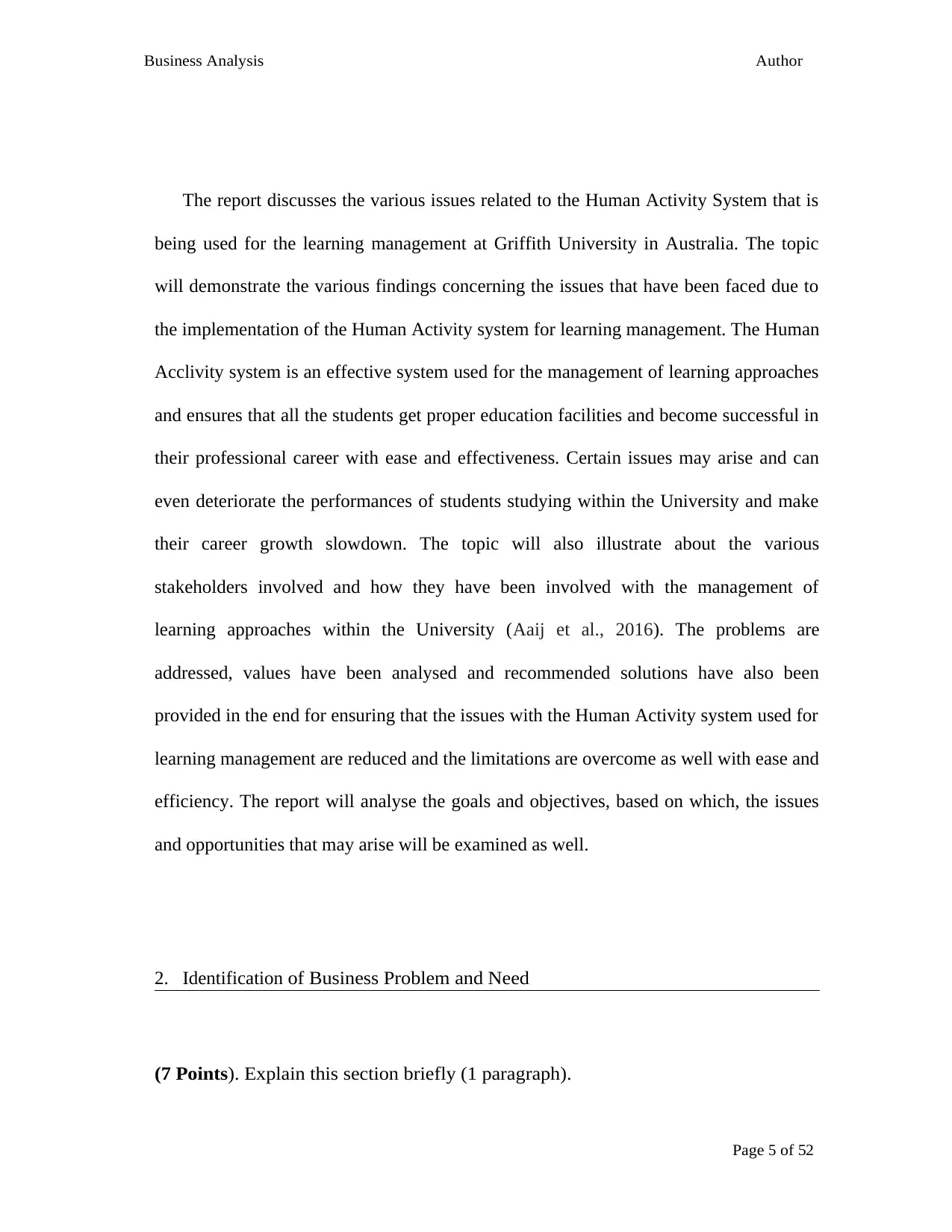
Page 5 of 52
Business Analysis
Report
Author
The report discusses the various issues related to the Human Activity System that is
being used for the learning management at Griffith University in Australia. The topic
will demonstrate the various findings concerning the issues that have been faced due to
the implementation of the Human Activity system for learning management. The Human
Acclivity system is an effective system used for the management of learning approaches
and ensures that all the students get proper education facilities and become successful in
their professional career with ease and effectiveness. Certain issues may arise and can
even deteriorate the performances of students studying within the University and make
their career growth slowdown. The topic will also illustrate about the various
stakeholders involved and how they have been involved with the management of
learning approaches within the University (Aaij et al., 2016). The problems are
addressed, values have been analysed and recommended solutions have also been
provided in the end for ensuring that the issues with the Human Activity system used for
learning management are reduced and the limitations are overcome as well with ease and
efficiency. The report will analyse the goals and objectives, based on which, the issues
and opportunities that may arise will be examined as well.
2. Identification of Business Problem and Need
(7 Points). Explain this section briefly (1 paragraph).
Business Analysis
Report
Author
The report discusses the various issues related to the Human Activity System that is
being used for the learning management at Griffith University in Australia. The topic
will demonstrate the various findings concerning the issues that have been faced due to
the implementation of the Human Activity system for learning management. The Human
Acclivity system is an effective system used for the management of learning approaches
and ensures that all the students get proper education facilities and become successful in
their professional career with ease and effectiveness. Certain issues may arise and can
even deteriorate the performances of students studying within the University and make
their career growth slowdown. The topic will also illustrate about the various
stakeholders involved and how they have been involved with the management of
learning approaches within the University (Aaij et al., 2016). The problems are
addressed, values have been analysed and recommended solutions have also been
provided in the end for ensuring that the issues with the Human Activity system used for
learning management are reduced and the limitations are overcome as well with ease and
efficiency. The report will analyse the goals and objectives, based on which, the issues
and opportunities that may arise will be examined as well.
2. Identification of Business Problem and Need
(7 Points). Explain this section briefly (1 paragraph).
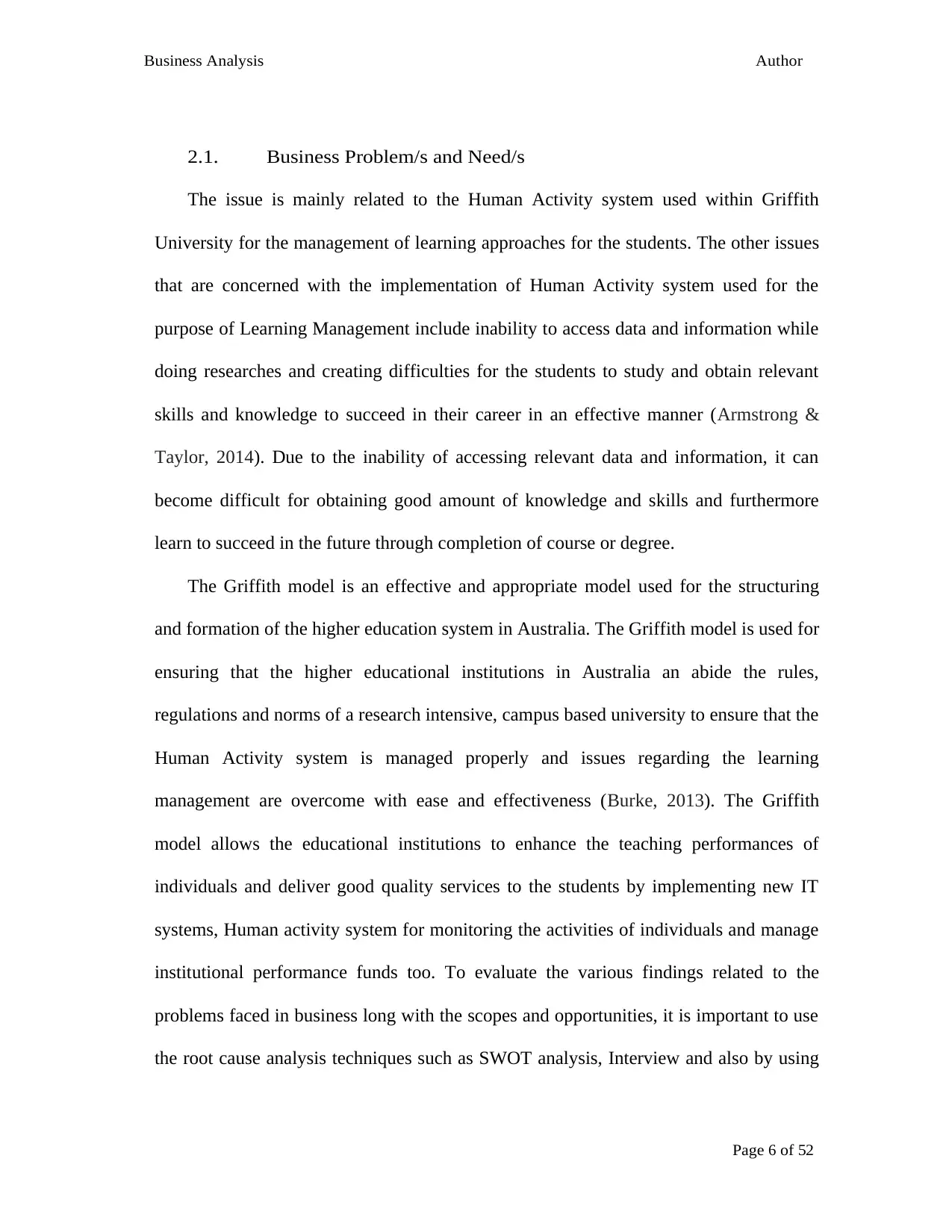
Page 6 of 52
Business Analysis
Report
Author
2.1. Business Problem/s and Need/s
The issue is mainly related to the Human Activity system used within Griffith
University for the management of learning approaches for the students. The other issues
that are concerned with the implementation of Human Activity system used for the
purpose of Learning Management include inability to access data and information while
doing researches and creating difficulties for the students to study and obtain relevant
skills and knowledge to succeed in their career in an effective manner (Armstrong &
Taylor, 2014). Due to the inability of accessing relevant data and information, it can
become difficult for obtaining good amount of knowledge and skills and furthermore
learn to succeed in the future through completion of course or degree.
The Griffith model is an effective and appropriate model used for the structuring
and formation of the higher education system in Australia. The Griffith model is used for
ensuring that the higher educational institutions in Australia an abide the rules,
regulations and norms of a research intensive, campus based university to ensure that the
Human Activity system is managed properly and issues regarding the learning
management are overcome with ease and effectiveness (Burke, 2013). The Griffith
model allows the educational institutions to enhance the teaching performances of
individuals and deliver good quality services to the students by implementing new IT
systems, Human activity system for monitoring the activities of individuals and manage
institutional performance funds too. To evaluate the various findings related to the
problems faced in business long with the scopes and opportunities, it is important to use
the root cause analysis techniques such as SWOT analysis, Interview and also by using
Business Analysis
Report
Author
2.1. Business Problem/s and Need/s
The issue is mainly related to the Human Activity system used within Griffith
University for the management of learning approaches for the students. The other issues
that are concerned with the implementation of Human Activity system used for the
purpose of Learning Management include inability to access data and information while
doing researches and creating difficulties for the students to study and obtain relevant
skills and knowledge to succeed in their career in an effective manner (Armstrong &
Taylor, 2014). Due to the inability of accessing relevant data and information, it can
become difficult for obtaining good amount of knowledge and skills and furthermore
learn to succeed in the future through completion of course or degree.
The Griffith model is an effective and appropriate model used for the structuring
and formation of the higher education system in Australia. The Griffith model is used for
ensuring that the higher educational institutions in Australia an abide the rules,
regulations and norms of a research intensive, campus based university to ensure that the
Human Activity system is managed properly and issues regarding the learning
management are overcome with ease and effectiveness (Burke, 2013). The Griffith
model allows the educational institutions to enhance the teaching performances of
individuals and deliver good quality services to the students by implementing new IT
systems, Human activity system for monitoring the activities of individuals and manage
institutional performance funds too. To evaluate the various findings related to the
problems faced in business long with the scopes and opportunities, it is important to use
the root cause analysis techniques such as SWOT analysis, Interview and also by using

Page 7 of 52
Business Analysis
Report
Author
the Five Whys technique (Card, 2016).
The SWOT analysis is used for identifying the strengths, weaknesses, opportunities
and threats experienced within the University in Australia. The SWOT analysis can also
help in determining the issues that have arisen considering the Human Activity system
used for Learning management at Griffith University. The strengths include affordable
educational facilities, location in the state capital, presence of full time faculties who
teach the classes most of the time (Conde et al., 2014). The relationship between the
teachers and students are quite good that has helped in managing the learning
approaches with much ease and efficiency. The organisation has also implemented new
systems of Information technology for the purpose of delivering comprehensive and user
friendly online education system. The Human activity system used for the learning
management has also been beneficial for handling the interdisciplinary and experimental
education at both the under graduate and post graduate levels. Enhanced faculty services
provided to the University and larger community is also considered as major strengths
here (Davis et al., 2012).
The weaknesses include lack of funding in several departments of the organisation,
lack of financial support, thin cultural and ethnic diversity, decline of students
enrolment, under staffing at various levels of the organisation, lack of implementation
and utilisation of resources for the purpose of managing the process of recruitment and
selection. Due to the lack of resources, there could be lesser expenditures on the IT
system and Human activity system, that might further result in inability to retain the
existing students and lack of skills to recruit and select individuals who can work for the
Business Analysis
Report
Author
the Five Whys technique (Card, 2016).
The SWOT analysis is used for identifying the strengths, weaknesses, opportunities
and threats experienced within the University in Australia. The SWOT analysis can also
help in determining the issues that have arisen considering the Human Activity system
used for Learning management at Griffith University. The strengths include affordable
educational facilities, location in the state capital, presence of full time faculties who
teach the classes most of the time (Conde et al., 2014). The relationship between the
teachers and students are quite good that has helped in managing the learning
approaches with much ease and efficiency. The organisation has also implemented new
systems of Information technology for the purpose of delivering comprehensive and user
friendly online education system. The Human activity system used for the learning
management has also been beneficial for handling the interdisciplinary and experimental
education at both the under graduate and post graduate levels. Enhanced faculty services
provided to the University and larger community is also considered as major strengths
here (Davis et al., 2012).
The weaknesses include lack of funding in several departments of the organisation,
lack of financial support, thin cultural and ethnic diversity, decline of students
enrolment, under staffing at various levels of the organisation, lack of implementation
and utilisation of resources for the purpose of managing the process of recruitment and
selection. Due to the lack of resources, there could be lesser expenditures on the IT
system and Human activity system, that might further result in inability to retain the
existing students and lack of skills to recruit and select individuals who can work for the
Secure Best Marks with AI Grader
Need help grading? Try our AI Grader for instant feedback on your assignments.

Page 8 of 52
Business Analysis
Report
Author
organisation (de Souza & Márcio de Almeida, 2013). Few other areas of weaknesses are
lack of proper infrastructure, underdeveloped campus life and issues with the HAS that
has created difficulties for the students to adopt the right learning approaches and access
information for their learning.
The opportunities that have arisen can help in creating a sustainable place in the
market and derive positive outcomes. Griffith University has used the HAS to deliver
online opportunities all over the world and ensure that good undergraduate experienced
is achieved by using the best learning management practices. The conversations and
partnerships are managed more easily with the employers (Department of Education and
Training, 2011). The Humana activity has not only enhanced the scopes for enhancing
the effectiveness of learning management approaches but also has developed various
international and off-campus study and exchange programs to deliver excellence and
become a leader in the field of interdisciplinary and integrated learning.
The threats that have risen due to the Human Activity system issues for learning
management are lack of funding for higher education faculties, more risks related to the
high turnover of faculties and staff members (Engeström, 2014). The huge amount of
competition in the market from the other Universities and presence of other private
educational institutions has created issues for sustaining in the competitive business
environment as well.
The interviews are conducted for gaining the feedbacks an responses of the students
about whether the students have been getting proper learning materials to access data
and information properly or not. As the topic revolved around the issue concerned with
Business Analysis
Report
Author
organisation (de Souza & Márcio de Almeida, 2013). Few other areas of weaknesses are
lack of proper infrastructure, underdeveloped campus life and issues with the HAS that
has created difficulties for the students to adopt the right learning approaches and access
information for their learning.
The opportunities that have arisen can help in creating a sustainable place in the
market and derive positive outcomes. Griffith University has used the HAS to deliver
online opportunities all over the world and ensure that good undergraduate experienced
is achieved by using the best learning management practices. The conversations and
partnerships are managed more easily with the employers (Department of Education and
Training, 2011). The Humana activity has not only enhanced the scopes for enhancing
the effectiveness of learning management approaches but also has developed various
international and off-campus study and exchange programs to deliver excellence and
become a leader in the field of interdisciplinary and integrated learning.
The threats that have risen due to the Human Activity system issues for learning
management are lack of funding for higher education faculties, more risks related to the
high turnover of faculties and staff members (Engeström, 2014). The huge amount of
competition in the market from the other Universities and presence of other private
educational institutions has created issues for sustaining in the competitive business
environment as well.
The interviews are conducted for gaining the feedbacks an responses of the students
about whether the students have been getting proper learning materials to access data
and information properly or not. As the topic revolved around the issue concerned with
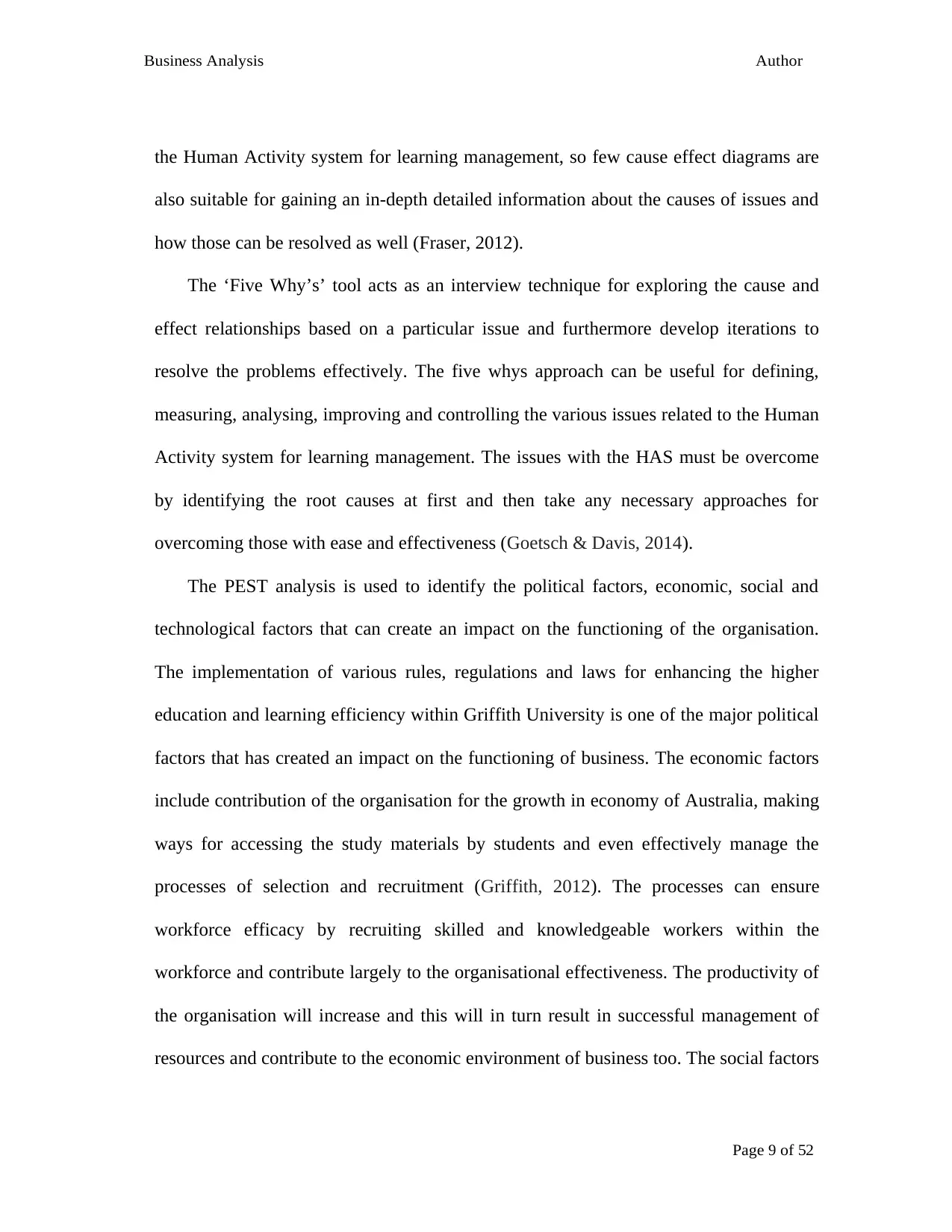
Page 9 of 52
Business Analysis
Report
Author
the Human Activity system for learning management, so few cause effect diagrams are
also suitable for gaining an in-depth detailed information about the causes of issues and
how those can be resolved as well (Fraser, 2012).
The ‘Five Why’s’ tool acts as an interview technique for exploring the cause and
effect relationships based on a particular issue and furthermore develop iterations to
resolve the problems effectively. The five whys approach can be useful for defining,
measuring, analysing, improving and controlling the various issues related to the Human
Activity system for learning management. The issues with the HAS must be overcome
by identifying the root causes at first and then take any necessary approaches for
overcoming those with ease and effectiveness (Goetsch & Davis, 2014).
The PEST analysis is used to identify the political factors, economic, social and
technological factors that can create an impact on the functioning of the organisation.
The implementation of various rules, regulations and laws for enhancing the higher
education and learning efficiency within Griffith University is one of the major political
factors that has created an impact on the functioning of business. The economic factors
include contribution of the organisation for the growth in economy of Australia, making
ways for accessing the study materials by students and even effectively manage the
processes of selection and recruitment (Griffith, 2012). The processes can ensure
workforce efficacy by recruiting skilled and knowledgeable workers within the
workforce and contribute largely to the organisational effectiveness. The productivity of
the organisation will increase and this will in turn result in successful management of
resources and contribute to the economic environment of business too. The social factors
Business Analysis
Report
Author
the Human Activity system for learning management, so few cause effect diagrams are
also suitable for gaining an in-depth detailed information about the causes of issues and
how those can be resolved as well (Fraser, 2012).
The ‘Five Why’s’ tool acts as an interview technique for exploring the cause and
effect relationships based on a particular issue and furthermore develop iterations to
resolve the problems effectively. The five whys approach can be useful for defining,
measuring, analysing, improving and controlling the various issues related to the Human
Activity system for learning management. The issues with the HAS must be overcome
by identifying the root causes at first and then take any necessary approaches for
overcoming those with ease and effectiveness (Goetsch & Davis, 2014).
The PEST analysis is used to identify the political factors, economic, social and
technological factors that can create an impact on the functioning of the organisation.
The implementation of various rules, regulations and laws for enhancing the higher
education and learning efficiency within Griffith University is one of the major political
factors that has created an impact on the functioning of business. The economic factors
include contribution of the organisation for the growth in economy of Australia, making
ways for accessing the study materials by students and even effectively manage the
processes of selection and recruitment (Griffith, 2012). The processes can ensure
workforce efficacy by recruiting skilled and knowledgeable workers within the
workforce and contribute largely to the organisational effectiveness. The productivity of
the organisation will increase and this will in turn result in successful management of
resources and contribute to the economic environment of business too. The social factors
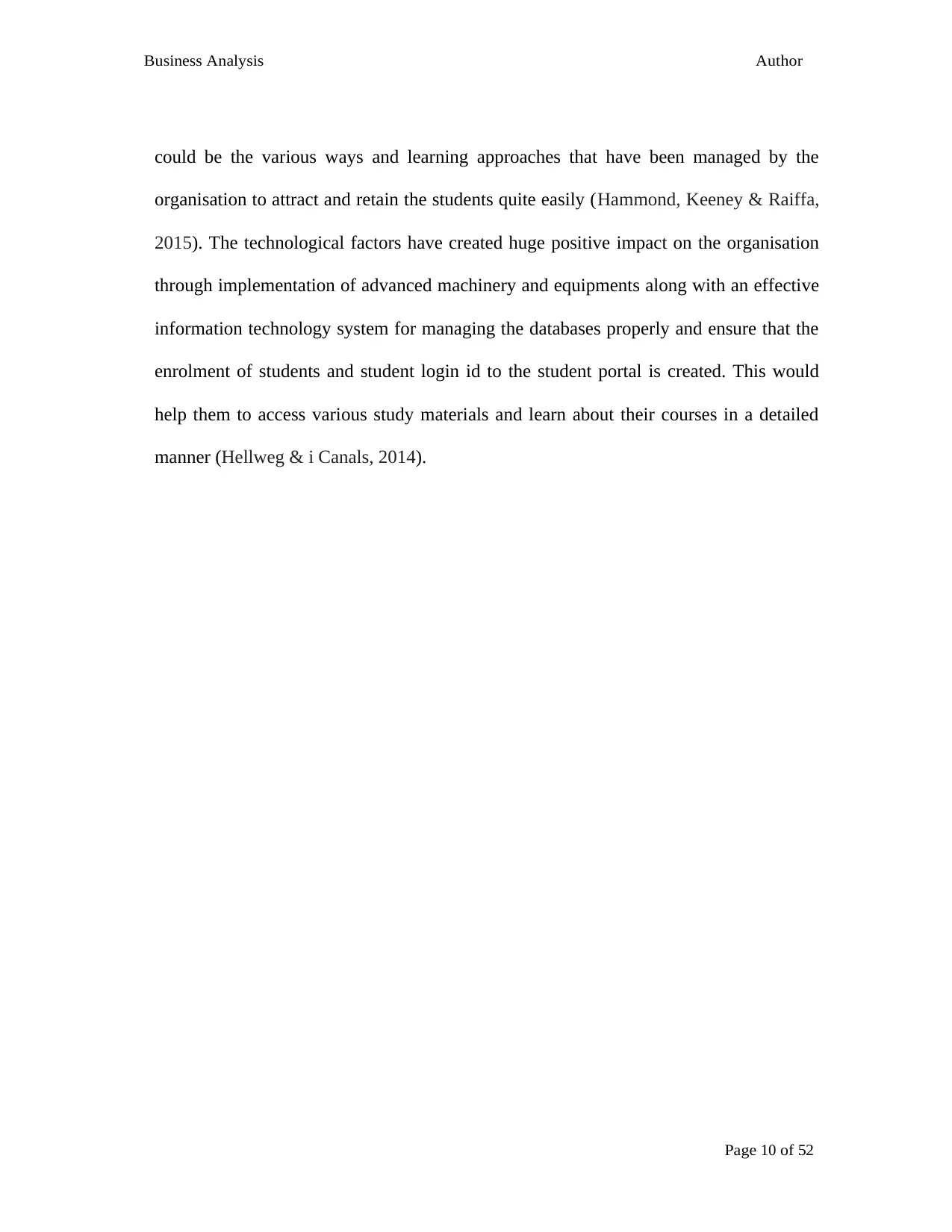
Page 10 of 52
Business Analysis
Report
Author
could be the various ways and learning approaches that have been managed by the
organisation to attract and retain the students quite easily (Hammond, Keeney & Raiffa,
2015). The technological factors have created huge positive impact on the organisation
through implementation of advanced machinery and equipments along with an effective
information technology system for managing the databases properly and ensure that the
enrolment of students and student login id to the student portal is created. This would
help them to access various study materials and learn about their courses in a detailed
manner (Hellweg & i Canals, 2014).
Business Analysis
Report
Author
could be the various ways and learning approaches that have been managed by the
organisation to attract and retain the students quite easily (Hammond, Keeney & Raiffa,
2015). The technological factors have created huge positive impact on the organisation
through implementation of advanced machinery and equipments along with an effective
information technology system for managing the databases properly and ensure that the
enrolment of students and student login id to the student portal is created. This would
help them to access various study materials and learn about their courses in a detailed
manner (Hellweg & i Canals, 2014).
Paraphrase This Document
Need a fresh take? Get an instant paraphrase of this document with our AI Paraphraser

Page 11 of 52
Business Analysis
Report
Author
2.2. Business Goals & Objectives
The goals and objectives of the business are to reduce the occurrence of issues
related to the Human Activity system for learning management and ensure that proper
learning approaches are devised for making the students learn, obtain relevant skills and
knowledge and succeed in their academic and professional career. There is also issues
concerned with the accessibility if information and so the objective also includes
management of proper learning approaches to allow the students access the data and
information and furthermore achieve the business outcomes properly. The objectives and
goals that are needed to be achieved have been defined with the help of SMART
objectives (Hewitt-Taylor, 2012).
Specific S – The specific objective is to deliver flexibility across the various degree
programs provided to the students.
Measurable M – The measurable objective is to determine how many students have
enrolled in the University to study a particular course and gain degree.
Agreed upon A – The agreed upon objective can be the delivery of more educational
opportunities and more options provided to learn a course and obtain relevant
knowledge and skills to become successful in their individual career.
Realistic or R – One of the realistic objective is to develop an online learning program to
allowing the students to study courses online and also get access to relevant data and
information with ease and effectiveness (Hollensen, 2015).
Time bound or T – The time bound objective means achievement of something within a
Business Analysis
Report
Author
2.2. Business Goals & Objectives
The goals and objectives of the business are to reduce the occurrence of issues
related to the Human Activity system for learning management and ensure that proper
learning approaches are devised for making the students learn, obtain relevant skills and
knowledge and succeed in their academic and professional career. There is also issues
concerned with the accessibility if information and so the objective also includes
management of proper learning approaches to allow the students access the data and
information and furthermore achieve the business outcomes properly. The objectives and
goals that are needed to be achieved have been defined with the help of SMART
objectives (Hewitt-Taylor, 2012).
Specific S – The specific objective is to deliver flexibility across the various degree
programs provided to the students.
Measurable M – The measurable objective is to determine how many students have
enrolled in the University to study a particular course and gain degree.
Agreed upon A – The agreed upon objective can be the delivery of more educational
opportunities and more options provided to learn a course and obtain relevant
knowledge and skills to become successful in their individual career.
Realistic or R – One of the realistic objective is to develop an online learning program to
allowing the students to study courses online and also get access to relevant data and
information with ease and effectiveness (Hollensen, 2015).
Time bound or T – The time bound objective means achievement of something within a
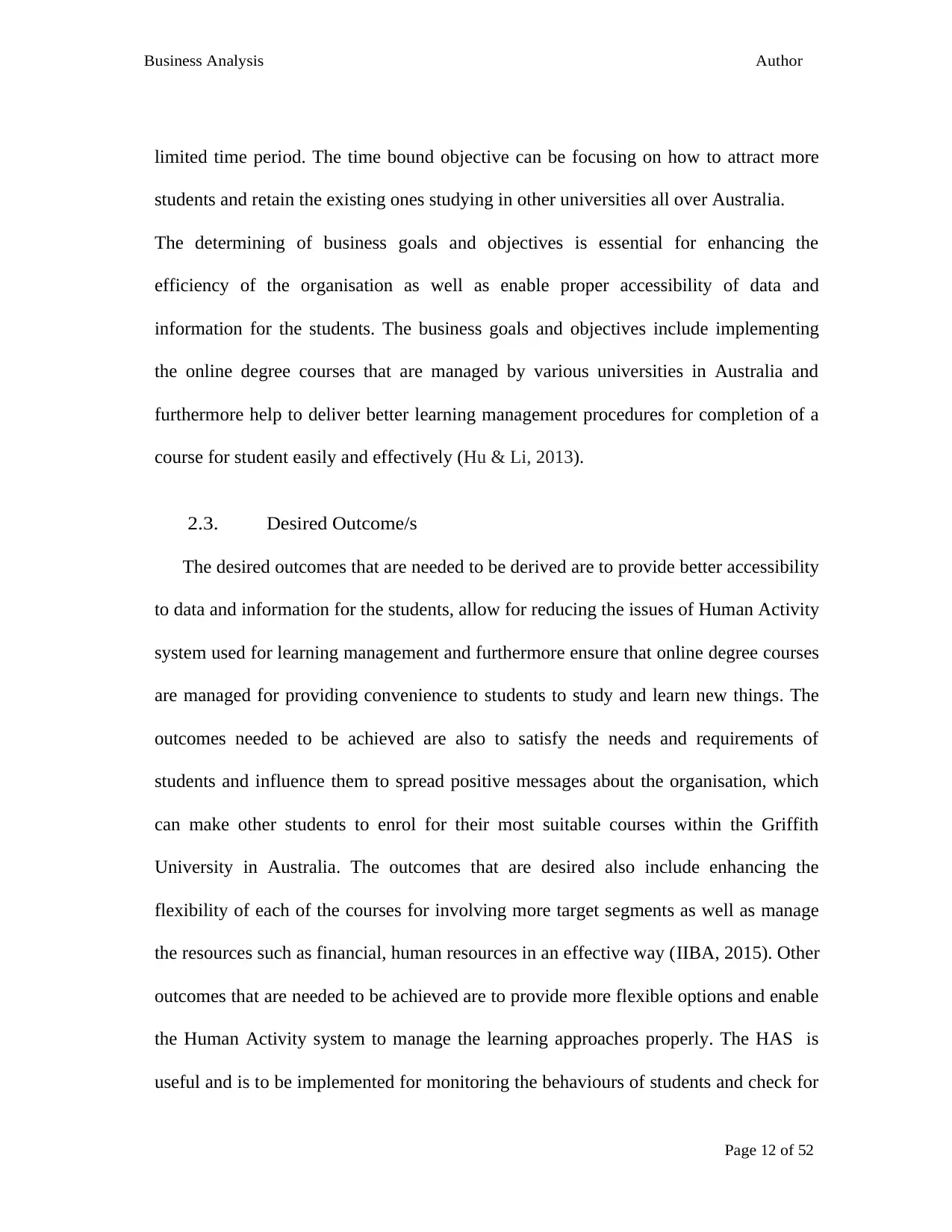
Page 12 of 52
Business Analysis
Report
Author
limited time period. The time bound objective can be focusing on how to attract more
students and retain the existing ones studying in other universities all over Australia.
The determining of business goals and objectives is essential for enhancing the
efficiency of the organisation as well as enable proper accessibility of data and
information for the students. The business goals and objectives include implementing
the online degree courses that are managed by various universities in Australia and
furthermore help to deliver better learning management procedures for completion of a
course for student easily and effectively (Hu & Li, 2013).
2.3. Desired Outcome/s
The desired outcomes that are needed to be derived are to provide better accessibility
to data and information for the students, allow for reducing the issues of Human Activity
system used for learning management and furthermore ensure that online degree courses
are managed for providing convenience to students to study and learn new things. The
outcomes needed to be achieved are also to satisfy the needs and requirements of
students and influence them to spread positive messages about the organisation, which
can make other students to enrol for their most suitable courses within the Griffith
University in Australia. The outcomes that are desired also include enhancing the
flexibility of each of the courses for involving more target segments as well as manage
the resources such as financial, human resources in an effective way (IIBA, 2015). Other
outcomes that are needed to be achieved are to provide more flexible options and enable
the Human Activity system to manage the learning approaches properly. The HAS is
useful and is to be implemented for monitoring the behaviours of students and check for
Business Analysis
Report
Author
limited time period. The time bound objective can be focusing on how to attract more
students and retain the existing ones studying in other universities all over Australia.
The determining of business goals and objectives is essential for enhancing the
efficiency of the organisation as well as enable proper accessibility of data and
information for the students. The business goals and objectives include implementing
the online degree courses that are managed by various universities in Australia and
furthermore help to deliver better learning management procedures for completion of a
course for student easily and effectively (Hu & Li, 2013).
2.3. Desired Outcome/s
The desired outcomes that are needed to be derived are to provide better accessibility
to data and information for the students, allow for reducing the issues of Human Activity
system used for learning management and furthermore ensure that online degree courses
are managed for providing convenience to students to study and learn new things. The
outcomes needed to be achieved are also to satisfy the needs and requirements of
students and influence them to spread positive messages about the organisation, which
can make other students to enrol for their most suitable courses within the Griffith
University in Australia. The outcomes that are desired also include enhancing the
flexibility of each of the courses for involving more target segments as well as manage
the resources such as financial, human resources in an effective way (IIBA, 2015). Other
outcomes that are needed to be achieved are to provide more flexible options and enable
the Human Activity system to manage the learning approaches properly. The HAS is
useful and is to be implemented for monitoring the behaviours of students and check for
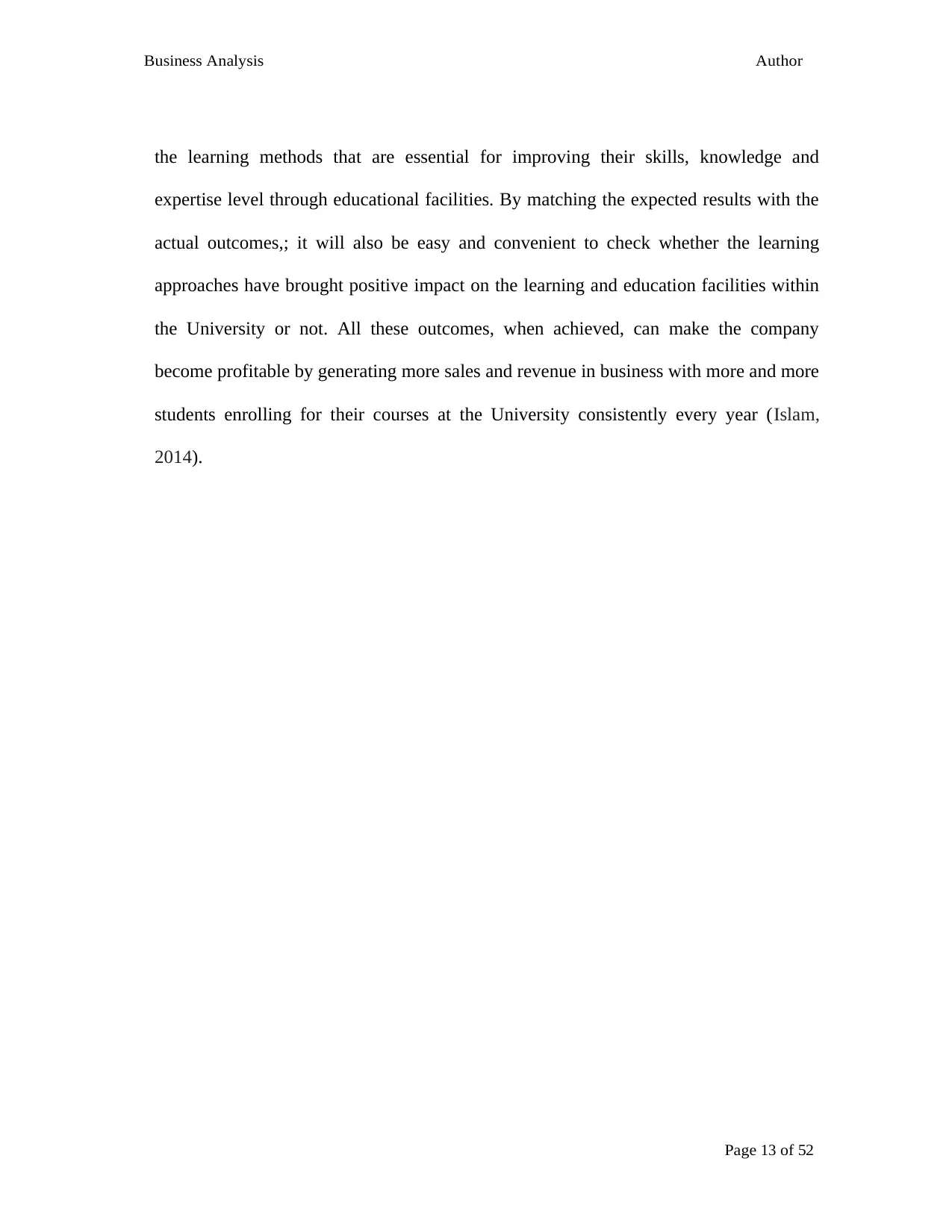
Page 13 of 52
Business Analysis
Report
Author
the learning methods that are essential for improving their skills, knowledge and
expertise level through educational facilities. By matching the expected results with the
actual outcomes,; it will also be easy and convenient to check whether the learning
approaches have brought positive impact on the learning and education facilities within
the University or not. All these outcomes, when achieved, can make the company
become profitable by generating more sales and revenue in business with more and more
students enrolling for their courses at the University consistently every year (Islam,
2014).
Business Analysis
Report
Author
the learning methods that are essential for improving their skills, knowledge and
expertise level through educational facilities. By matching the expected results with the
actual outcomes,; it will also be easy and convenient to check whether the learning
approaches have brought positive impact on the learning and education facilities within
the University or not. All these outcomes, when achieved, can make the company
become profitable by generating more sales and revenue in business with more and more
students enrolling for their courses at the University consistently every year (Islam,
2014).
Secure Best Marks with AI Grader
Need help grading? Try our AI Grader for instant feedback on your assignments.
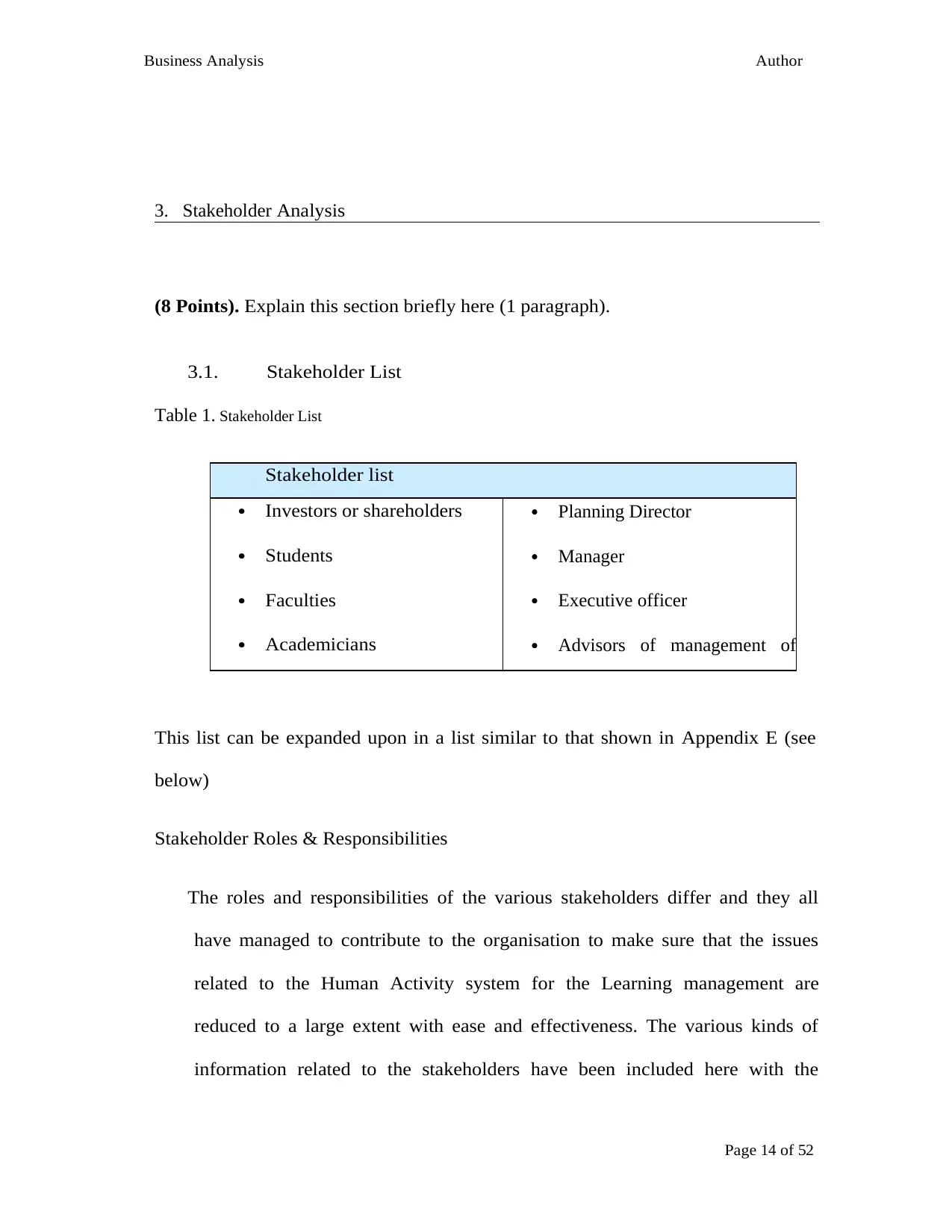
Page 14 of 52
Business Analysis
Report
Author
3. Stakeholder Analysis
(8 Points). Explain this section briefly here (1 paragraph).
3.1. Stakeholder List
Table 1. Stakeholder List
Stakeholder list
Investors or shareholders
Students
Faculties
Academicians
Planning Director
Manager
Executive officer
Advisors of management of
career
This list can be expanded upon in a list similar to that shown in Appendix E (see
below)
Stakeholder Roles & Responsibilities
The roles and responsibilities of the various stakeholders differ and they all
have managed to contribute to the organisation to make sure that the issues
related to the Human Activity system for the Learning management are
reduced to a large extent with ease and effectiveness. The various kinds of
information related to the stakeholders have been included here with the
Business Analysis
Report
Author
3. Stakeholder Analysis
(8 Points). Explain this section briefly here (1 paragraph).
3.1. Stakeholder List
Table 1. Stakeholder List
Stakeholder list
Investors or shareholders
Students
Faculties
Academicians
Planning Director
Manager
Executive officer
Advisors of management of
career
This list can be expanded upon in a list similar to that shown in Appendix E (see
below)
Stakeholder Roles & Responsibilities
The roles and responsibilities of the various stakeholders differ and they all
have managed to contribute to the organisation to make sure that the issues
related to the Human Activity system for the Learning management are
reduced to a large extent with ease and effectiveness. The various kinds of
information related to the stakeholders have been included here with the
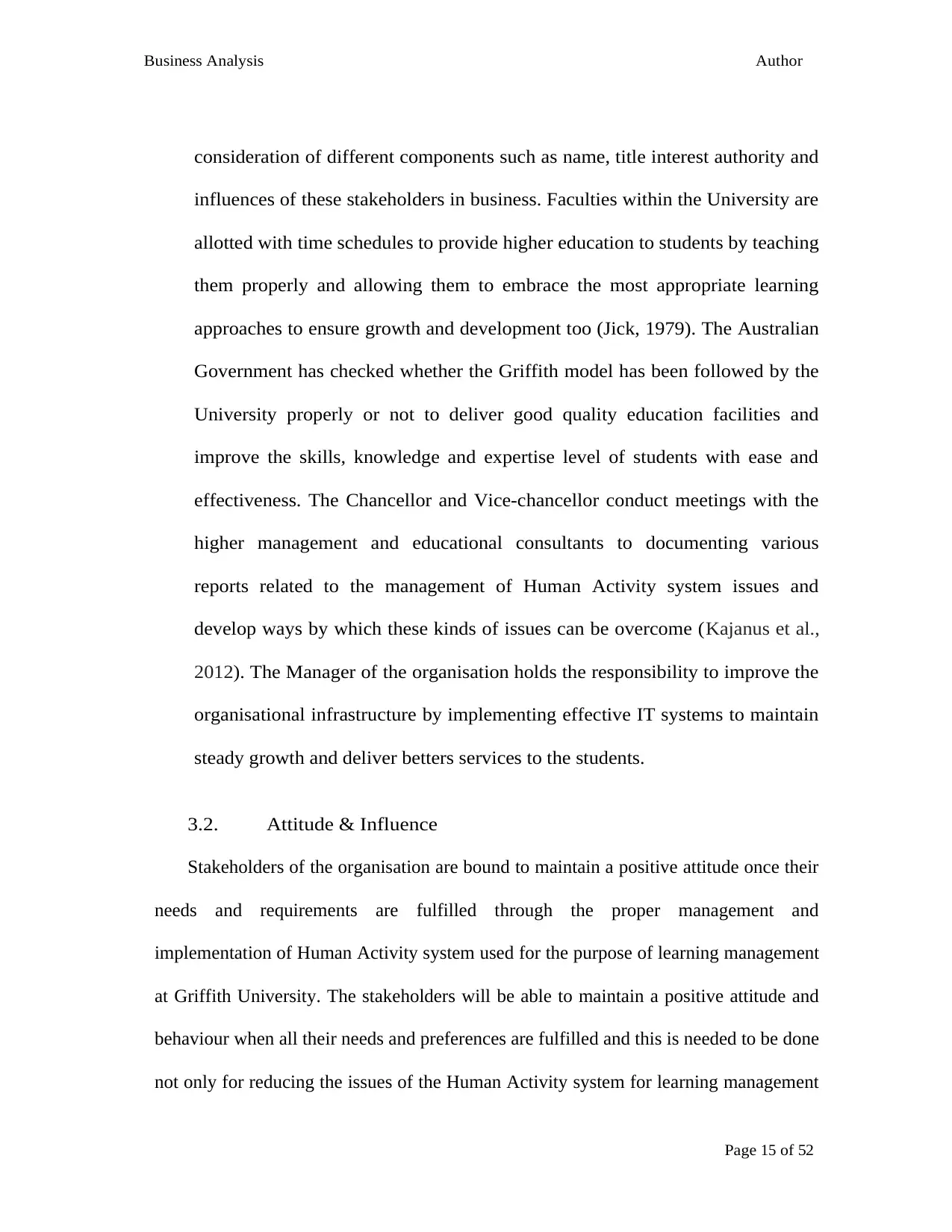
Page 15 of 52
Business Analysis
Report
Author
consideration of different components such as name, title interest authority and
influences of these stakeholders in business. Faculties within the University are
allotted with time schedules to provide higher education to students by teaching
them properly and allowing them to embrace the most appropriate learning
approaches to ensure growth and development too (Jick, 1979). The Australian
Government has checked whether the Griffith model has been followed by the
University properly or not to deliver good quality education facilities and
improve the skills, knowledge and expertise level of students with ease and
effectiveness. The Chancellor and Vice-chancellor conduct meetings with the
higher management and educational consultants to documenting various
reports related to the management of Human Activity system issues and
develop ways by which these kinds of issues can be overcome (Kajanus et al.,
2012). The Manager of the organisation holds the responsibility to improve the
organisational infrastructure by implementing effective IT systems to maintain
steady growth and deliver betters services to the students.
3.2. Attitude & Influence
Stakeholders of the organisation are bound to maintain a positive attitude once their
needs and requirements are fulfilled through the proper management and
implementation of Human Activity system used for the purpose of learning management
at Griffith University. The stakeholders will be able to maintain a positive attitude and
behaviour when all their needs and preferences are fulfilled and this is needed to be done
not only for reducing the issues of the Human Activity system for learning management
Business Analysis
Report
Author
consideration of different components such as name, title interest authority and
influences of these stakeholders in business. Faculties within the University are
allotted with time schedules to provide higher education to students by teaching
them properly and allowing them to embrace the most appropriate learning
approaches to ensure growth and development too (Jick, 1979). The Australian
Government has checked whether the Griffith model has been followed by the
University properly or not to deliver good quality education facilities and
improve the skills, knowledge and expertise level of students with ease and
effectiveness. The Chancellor and Vice-chancellor conduct meetings with the
higher management and educational consultants to documenting various
reports related to the management of Human Activity system issues and
develop ways by which these kinds of issues can be overcome (Kajanus et al.,
2012). The Manager of the organisation holds the responsibility to improve the
organisational infrastructure by implementing effective IT systems to maintain
steady growth and deliver betters services to the students.
3.2. Attitude & Influence
Stakeholders of the organisation are bound to maintain a positive attitude once their
needs and requirements are fulfilled through the proper management and
implementation of Human Activity system used for the purpose of learning management
at Griffith University. The stakeholders will be able to maintain a positive attitude and
behaviour when all their needs and preferences are fulfilled and this is needed to be done
not only for reducing the issues of the Human Activity system for learning management

Page 16 of 52
Business Analysis
Report
Author
but also ensure that the lack of accessibility of data and information is reduced largely.
This would help in management of financial and human resources as well as implement
the most appropriate information technology system to manage the business operations
and processes easily (Kenneth & Kilmann, 2002). This would also help in keeping the
learning management practices on track and ensure that these are properly delivered to
the students for their career growth and well being. The stakeholders who have the most
influences on the organisation include Chancellor and Vice-chancellor, Government of
Australia, managers, career advisors and the most important students who are
responsible for the success of the organisation. It is the duty of the organisation to fulfil
the demands and expectations of students and deliver the right kinds of learning
approaches to them for allowing them to progress in their career by gaining a degree
from the course completion (Kohfeldt & Langhout, 2012).
3.3. Stakeholder Relationships and Mapping
The stakeholder mapping determines the various stakeholders involved with the
implementation of Human Activity system for learning management and the relationship
that exits among them. All the internal and external stakeholder relationships are linked
together to form a relationship and this has been done by Griffith University by using the
onion diagram. The Onion diagram presents the various stakeholders into various
categories and are presented within the circles that constitute the Onion diagram. The
stakeholder matrix is also used as an effective tool for mapping of stakeholders and
design new programs with the involvement of various individuals who have been
involved with the Human Activity system at Griffith University in Australia (Kolb &
Business Analysis
Report
Author
but also ensure that the lack of accessibility of data and information is reduced largely.
This would help in management of financial and human resources as well as implement
the most appropriate information technology system to manage the business operations
and processes easily (Kenneth & Kilmann, 2002). This would also help in keeping the
learning management practices on track and ensure that these are properly delivered to
the students for their career growth and well being. The stakeholders who have the most
influences on the organisation include Chancellor and Vice-chancellor, Government of
Australia, managers, career advisors and the most important students who are
responsible for the success of the organisation. It is the duty of the organisation to fulfil
the demands and expectations of students and deliver the right kinds of learning
approaches to them for allowing them to progress in their career by gaining a degree
from the course completion (Kohfeldt & Langhout, 2012).
3.3. Stakeholder Relationships and Mapping
The stakeholder mapping determines the various stakeholders involved with the
implementation of Human Activity system for learning management and the relationship
that exits among them. All the internal and external stakeholder relationships are linked
together to form a relationship and this has been done by Griffith University by using the
onion diagram. The Onion diagram presents the various stakeholders into various
categories and are presented within the circles that constitute the Onion diagram. The
stakeholder matrix is also used as an effective tool for mapping of stakeholders and
design new programs with the involvement of various individuals who have been
involved with the Human Activity system at Griffith University in Australia (Kolb &
Paraphrase This Document
Need a fresh take? Get an instant paraphrase of this document with our AI Paraphraser
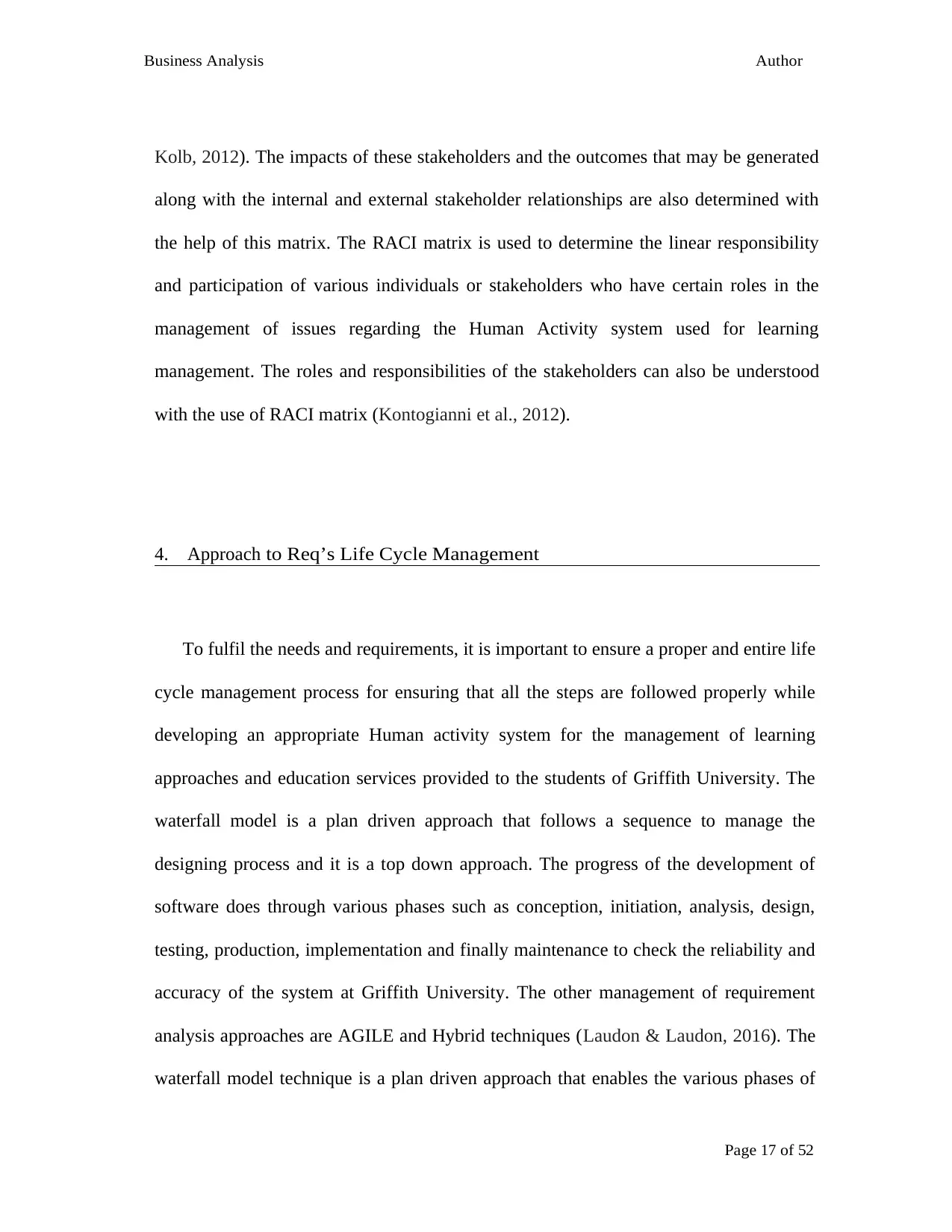
Page 17 of 52
Business Analysis
Report
Author
Kolb, 2012). The impacts of these stakeholders and the outcomes that may be generated
along with the internal and external stakeholder relationships are also determined with
the help of this matrix. The RACI matrix is used to determine the linear responsibility
and participation of various individuals or stakeholders who have certain roles in the
management of issues regarding the Human Activity system used for learning
management. The roles and responsibilities of the stakeholders can also be understood
with the use of RACI matrix (Kontogianni et al., 2012).
4. Approach to Req’s Life Cycle Management
To fulfil the needs and requirements, it is important to ensure a proper and entire life
cycle management process for ensuring that all the steps are followed properly while
developing an appropriate Human activity system for the management of learning
approaches and education services provided to the students of Griffith University. The
waterfall model is a plan driven approach that follows a sequence to manage the
designing process and it is a top down approach. The progress of the development of
software does through various phases such as conception, initiation, analysis, design,
testing, production, implementation and finally maintenance to check the reliability and
accuracy of the system at Griffith University. The other management of requirement
analysis approaches are AGILE and Hybrid techniques (Laudon & Laudon, 2016). The
waterfall model technique is a plan driven approach that enables the various phases of
Business Analysis
Report
Author
Kolb, 2012). The impacts of these stakeholders and the outcomes that may be generated
along with the internal and external stakeholder relationships are also determined with
the help of this matrix. The RACI matrix is used to determine the linear responsibility
and participation of various individuals or stakeholders who have certain roles in the
management of issues regarding the Human Activity system used for learning
management. The roles and responsibilities of the stakeholders can also be understood
with the use of RACI matrix (Kontogianni et al., 2012).
4. Approach to Req’s Life Cycle Management
To fulfil the needs and requirements, it is important to ensure a proper and entire life
cycle management process for ensuring that all the steps are followed properly while
developing an appropriate Human activity system for the management of learning
approaches and education services provided to the students of Griffith University. The
waterfall model is a plan driven approach that follows a sequence to manage the
designing process and it is a top down approach. The progress of the development of
software does through various phases such as conception, initiation, analysis, design,
testing, production, implementation and finally maintenance to check the reliability and
accuracy of the system at Griffith University. The other management of requirement
analysis approaches are AGILE and Hybrid techniques (Laudon & Laudon, 2016). The
waterfall model technique is a plan driven approach that enables the various phases of
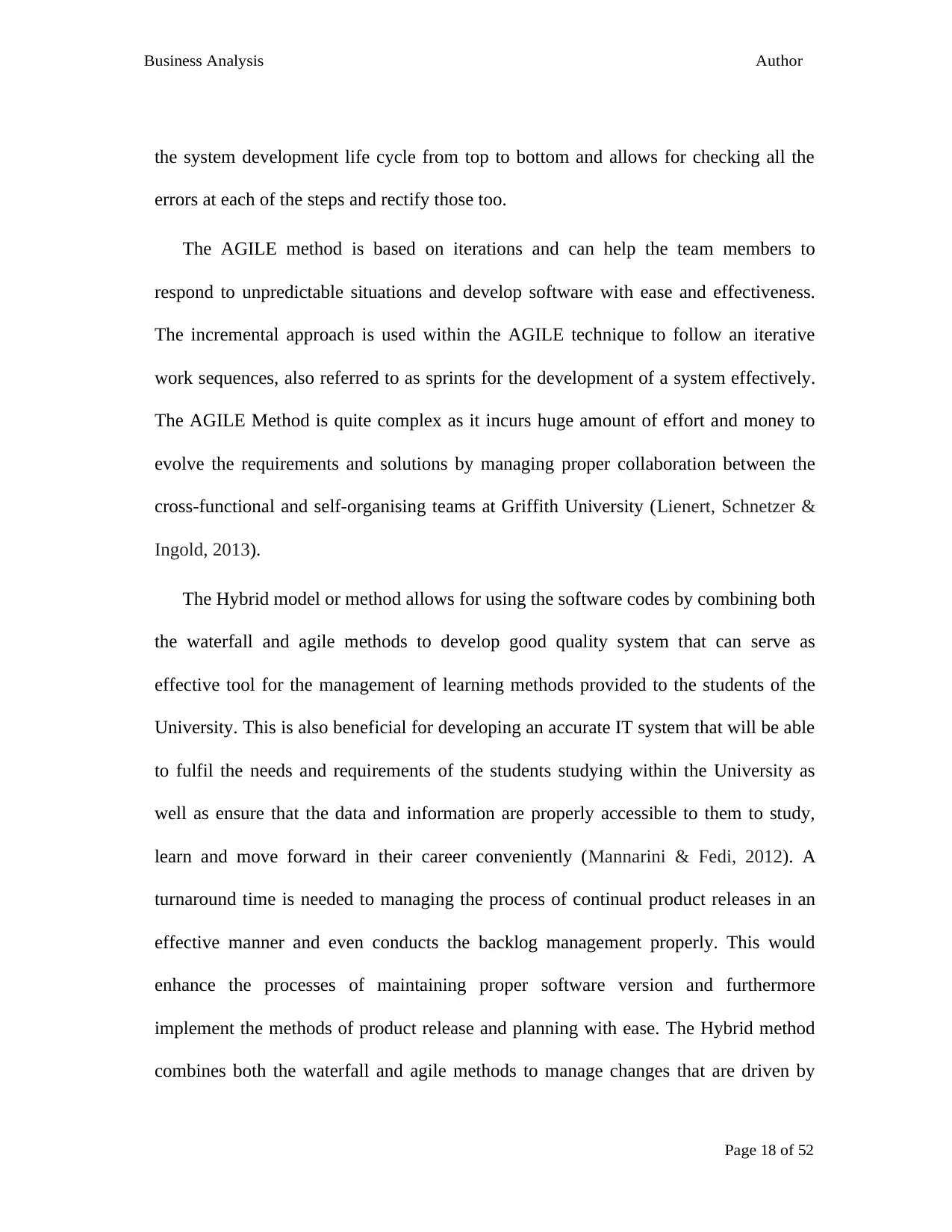
Page 18 of 52
Business Analysis
Report
Author
the system development life cycle from top to bottom and allows for checking all the
errors at each of the steps and rectify those too.
The AGILE method is based on iterations and can help the team members to
respond to unpredictable situations and develop software with ease and effectiveness.
The incremental approach is used within the AGILE technique to follow an iterative
work sequences, also referred to as sprints for the development of a system effectively.
The AGILE Method is quite complex as it incurs huge amount of effort and money to
evolve the requirements and solutions by managing proper collaboration between the
cross-functional and self-organising teams at Griffith University (Lienert, Schnetzer &
Ingold, 2013).
The Hybrid model or method allows for using the software codes by combining both
the waterfall and agile methods to develop good quality system that can serve as
effective tool for the management of learning methods provided to the students of the
University. This is also beneficial for developing an accurate IT system that will be able
to fulfil the needs and requirements of the students studying within the University as
well as ensure that the data and information are properly accessible to them to study,
learn and move forward in their career conveniently (Mannarini & Fedi, 2012). A
turnaround time is needed to managing the process of continual product releases in an
effective manner and even conducts the backlog management properly. This would
enhance the processes of maintaining proper software version and furthermore
implement the methods of product release and planning with ease. The Hybrid method
combines both the waterfall and agile methods to manage changes that are driven by
Business Analysis
Report
Author
the system development life cycle from top to bottom and allows for checking all the
errors at each of the steps and rectify those too.
The AGILE method is based on iterations and can help the team members to
respond to unpredictable situations and develop software with ease and effectiveness.
The incremental approach is used within the AGILE technique to follow an iterative
work sequences, also referred to as sprints for the development of a system effectively.
The AGILE Method is quite complex as it incurs huge amount of effort and money to
evolve the requirements and solutions by managing proper collaboration between the
cross-functional and self-organising teams at Griffith University (Lienert, Schnetzer &
Ingold, 2013).
The Hybrid model or method allows for using the software codes by combining both
the waterfall and agile methods to develop good quality system that can serve as
effective tool for the management of learning methods provided to the students of the
University. This is also beneficial for developing an accurate IT system that will be able
to fulfil the needs and requirements of the students studying within the University as
well as ensure that the data and information are properly accessible to them to study,
learn and move forward in their career conveniently (Mannarini & Fedi, 2012). A
turnaround time is needed to managing the process of continual product releases in an
effective manner and even conducts the backlog management properly. This would
enhance the processes of maintaining proper software version and furthermore
implement the methods of product release and planning with ease. The Hybrid method
combines both the waterfall and agile methods to manage changes that are driven by
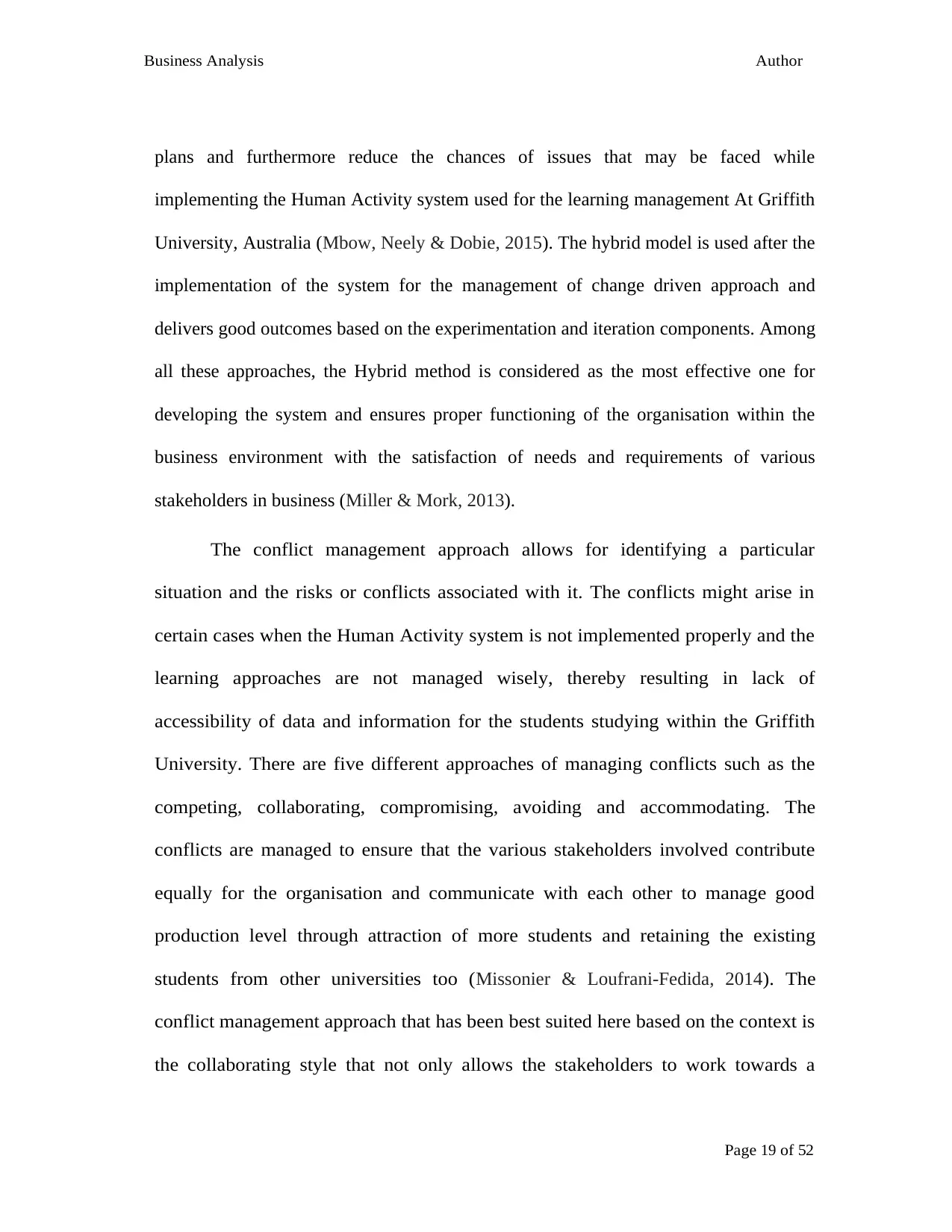
Page 19 of 52
Business Analysis
Report
Author
plans and furthermore reduce the chances of issues that may be faced while
implementing the Human Activity system used for the learning management At Griffith
University, Australia (Mbow, Neely & Dobie, 2015). The hybrid model is used after the
implementation of the system for the management of change driven approach and
delivers good outcomes based on the experimentation and iteration components. Among
all these approaches, the Hybrid method is considered as the most effective one for
developing the system and ensures proper functioning of the organisation within the
business environment with the satisfaction of needs and requirements of various
stakeholders in business (Miller & Mork, 2013).
The conflict management approach allows for identifying a particular
situation and the risks or conflicts associated with it. The conflicts might arise in
certain cases when the Human Activity system is not implemented properly and the
learning approaches are not managed wisely, thereby resulting in lack of
accessibility of data and information for the students studying within the Griffith
University. There are five different approaches of managing conflicts such as the
competing, collaborating, compromising, avoiding and accommodating. The
conflicts are managed to ensure that the various stakeholders involved contribute
equally for the organisation and communicate with each other to manage good
production level through attraction of more students and retaining the existing
students from other universities too (Missonier & Loufrani-Fedida, 2014 ). The
conflict management approach that has been best suited here based on the context is
the collaborating style that not only allows the stakeholders to work towards a
Business Analysis
Report
Author
plans and furthermore reduce the chances of issues that may be faced while
implementing the Human Activity system used for the learning management At Griffith
University, Australia (Mbow, Neely & Dobie, 2015). The hybrid model is used after the
implementation of the system for the management of change driven approach and
delivers good outcomes based on the experimentation and iteration components. Among
all these approaches, the Hybrid method is considered as the most effective one for
developing the system and ensures proper functioning of the organisation within the
business environment with the satisfaction of needs and requirements of various
stakeholders in business (Miller & Mork, 2013).
The conflict management approach allows for identifying a particular
situation and the risks or conflicts associated with it. The conflicts might arise in
certain cases when the Human Activity system is not implemented properly and the
learning approaches are not managed wisely, thereby resulting in lack of
accessibility of data and information for the students studying within the Griffith
University. There are five different approaches of managing conflicts such as the
competing, collaborating, compromising, avoiding and accommodating. The
conflicts are managed to ensure that the various stakeholders involved contribute
equally for the organisation and communicate with each other to manage good
production level through attraction of more students and retaining the existing
students from other universities too (Missonier & Loufrani-Fedida, 2014 ). The
conflict management approach that has been best suited here based on the context is
the collaborating style that not only allows the stakeholders to work towards a
Secure Best Marks with AI Grader
Need help grading? Try our AI Grader for instant feedback on your assignments.
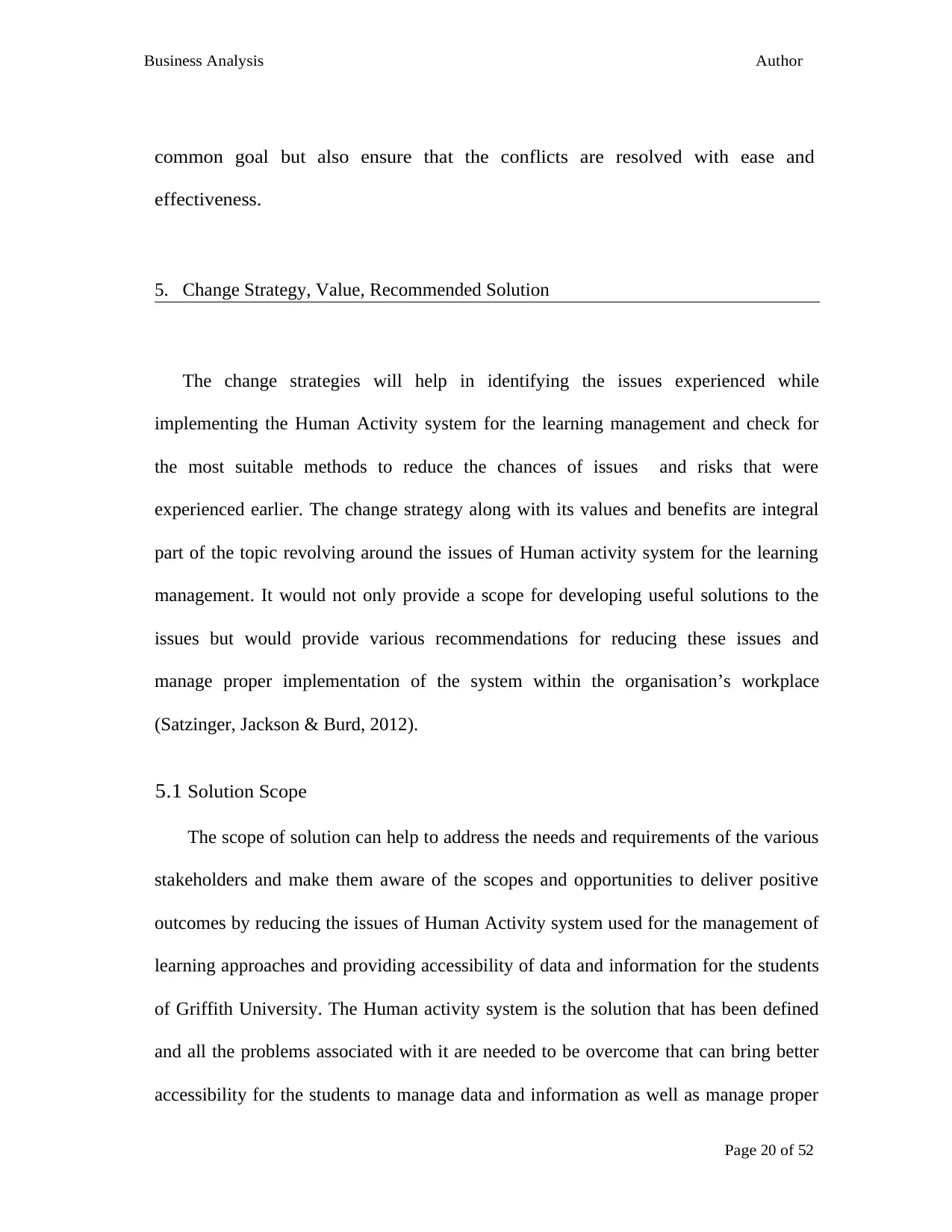
Page 20 of 52
Business Analysis
Report
Author
common goal but also ensure that the conflicts are resolved with ease and
effectiveness.
5. Change Strategy, Value, Recommended Solution
The change strategies will help in identifying the issues experienced while
implementing the Human Activity system for the learning management and check for
the most suitable methods to reduce the chances of issues and risks that were
experienced earlier. The change strategy along with its values and benefits are integral
part of the topic revolving around the issues of Human activity system for the learning
management. It would not only provide a scope for developing useful solutions to the
issues but would provide various recommendations for reducing these issues and
manage proper implementation of the system within the organisation’s workplace
(Satzinger, Jackson & Burd, 2012).
5.1 Solution Scope
The scope of solution can help to address the needs and requirements of the various
stakeholders and make them aware of the scopes and opportunities to deliver positive
outcomes by reducing the issues of Human Activity system used for the management of
learning approaches and providing accessibility of data and information for the students
of Griffith University. The Human activity system is the solution that has been defined
and all the problems associated with it are needed to be overcome that can bring better
accessibility for the students to manage data and information as well as manage proper
Business Analysis
Report
Author
common goal but also ensure that the conflicts are resolved with ease and
effectiveness.
5. Change Strategy, Value, Recommended Solution
The change strategies will help in identifying the issues experienced while
implementing the Human Activity system for the learning management and check for
the most suitable methods to reduce the chances of issues and risks that were
experienced earlier. The change strategy along with its values and benefits are integral
part of the topic revolving around the issues of Human activity system for the learning
management. It would not only provide a scope for developing useful solutions to the
issues but would provide various recommendations for reducing these issues and
manage proper implementation of the system within the organisation’s workplace
(Satzinger, Jackson & Burd, 2012).
5.1 Solution Scope
The scope of solution can help to address the needs and requirements of the various
stakeholders and make them aware of the scopes and opportunities to deliver positive
outcomes by reducing the issues of Human Activity system used for the management of
learning approaches and providing accessibility of data and information for the students
of Griffith University. The Human activity system is the solution that has been defined
and all the problems associated with it are needed to be overcome that can bring better
accessibility for the students to manage data and information as well as manage proper

Page 21 of 52
Business Analysis
Report
Author
business functions and processes. The solutions cope would define the business need, its
impac6 and probable measures that could be undertaken for resolving the issues of
Human activity system for learning management at Griffith University (Serrat, 2017).
The solution scope would identify the problem scope at first and then ensure that the
needs of stakeholders are identified and how could they support the system to derive
positive outcomes for the organisation. It is also important to revise the system with the
consideration of stakeholders like IT service staffs, faculties, academicians and career
advisor who holds the responsibilities of preparing time tables, manage the student
portal access by providing them with login id and password and maintain the University
web site too through proper implementation of IT system. The sotehr stakeholders are
assigned with the roles of managing the IT framework and accounting systems, teaching
of students and advise them about the career growth and opportunities available too
(Seuring, 2013).
The Australian Government has implemented certain rules, regulations and laws for
the management of higher education in an appropriate manner and check whether the
services delivered to the students have complied with the standards of quality and
organisational rules or not. The solution scope would also allow for revising the Human
activity system properly and improve the IT system framework for successful
implementation of learning approaches, management of courses and student portal. This
would assist the students by providing them with learning materials and even teach them
according to the time slot allotted to the faculties and academicians to teach them
(Soosay, Fearne & Dent, 2012). With the advancement in technology and
communication, various technological changes are possible that can not only improve
Business Analysis
Report
Author
business functions and processes. The solutions cope would define the business need, its
impac6 and probable measures that could be undertaken for resolving the issues of
Human activity system for learning management at Griffith University (Serrat, 2017).
The solution scope would identify the problem scope at first and then ensure that the
needs of stakeholders are identified and how could they support the system to derive
positive outcomes for the organisation. It is also important to revise the system with the
consideration of stakeholders like IT service staffs, faculties, academicians and career
advisor who holds the responsibilities of preparing time tables, manage the student
portal access by providing them with login id and password and maintain the University
web site too through proper implementation of IT system. The sotehr stakeholders are
assigned with the roles of managing the IT framework and accounting systems, teaching
of students and advise them about the career growth and opportunities available too
(Seuring, 2013).
The Australian Government has implemented certain rules, regulations and laws for
the management of higher education in an appropriate manner and check whether the
services delivered to the students have complied with the standards of quality and
organisational rules or not. The solution scope would also allow for revising the Human
activity system properly and improve the IT system framework for successful
implementation of learning approaches, management of courses and student portal. This
would assist the students by providing them with learning materials and even teach them
according to the time slot allotted to the faculties and academicians to teach them
(Soosay, Fearne & Dent, 2012). With the advancement in technology and
communication, various technological changes are possible that can not only improve

Page 22 of 52
Business Analysis
Report
Author
the organisational infrastructure and support the services by ensuring delivery of good
quality educational programs to the students. This would ensure accreditation by the
Australian Universities and ensure that the degree courses and programs allotted to the
students are of good quality and can meet the expectations and demands of the service
users.
The Force field analysis is used to support the various management approaches
and deliver a good solution scope as well. This model can help in assisting the
stakeholders of the organisation to make decisions by maintaining balance between
the forces that influence the changes and the forces that resist the changes. The
proposed changes are illustrated in the Force field analysis table in between that has
resulted from by maintaining balance between the influencing and resisting forces.
The major forces to enabling changes are both internal and external drivers such as
existing or old machineries and products, lack of morale among the team members,
need for increasing the profit generation, volatile working environment, change in
demographic conditions, etc (Stark, 2015).
The forces against change include the old structures of the organisation, lack of
planning skills, attitudes and absence of positive behaviours. There are external
factors for resisting change too such as existing partners, Government laws,
legislations, rules and regulations along with obligation towards customers and
responsibilities to fulfil their needs and requirements properly.
To provide support toward the supporting forces outlined in the Force Field
diagram, the risk of the opposing forces of the model, must be mitigated and
Business Analysis
Report
Author
the organisational infrastructure and support the services by ensuring delivery of good
quality educational programs to the students. This would ensure accreditation by the
Australian Universities and ensure that the degree courses and programs allotted to the
students are of good quality and can meet the expectations and demands of the service
users.
The Force field analysis is used to support the various management approaches
and deliver a good solution scope as well. This model can help in assisting the
stakeholders of the organisation to make decisions by maintaining balance between
the forces that influence the changes and the forces that resist the changes. The
proposed changes are illustrated in the Force field analysis table in between that has
resulted from by maintaining balance between the influencing and resisting forces.
The major forces to enabling changes are both internal and external drivers such as
existing or old machineries and products, lack of morale among the team members,
need for increasing the profit generation, volatile working environment, change in
demographic conditions, etc (Stark, 2015).
The forces against change include the old structures of the organisation, lack of
planning skills, attitudes and absence of positive behaviours. There are external
factors for resisting change too such as existing partners, Government laws,
legislations, rules and regulations along with obligation towards customers and
responsibilities to fulfil their needs and requirements properly.
To provide support toward the supporting forces outlined in the Force Field
diagram, the risk of the opposing forces of the model, must be mitigated and
Paraphrase This Document
Need a fresh take? Get an instant paraphrase of this document with our AI Paraphraser
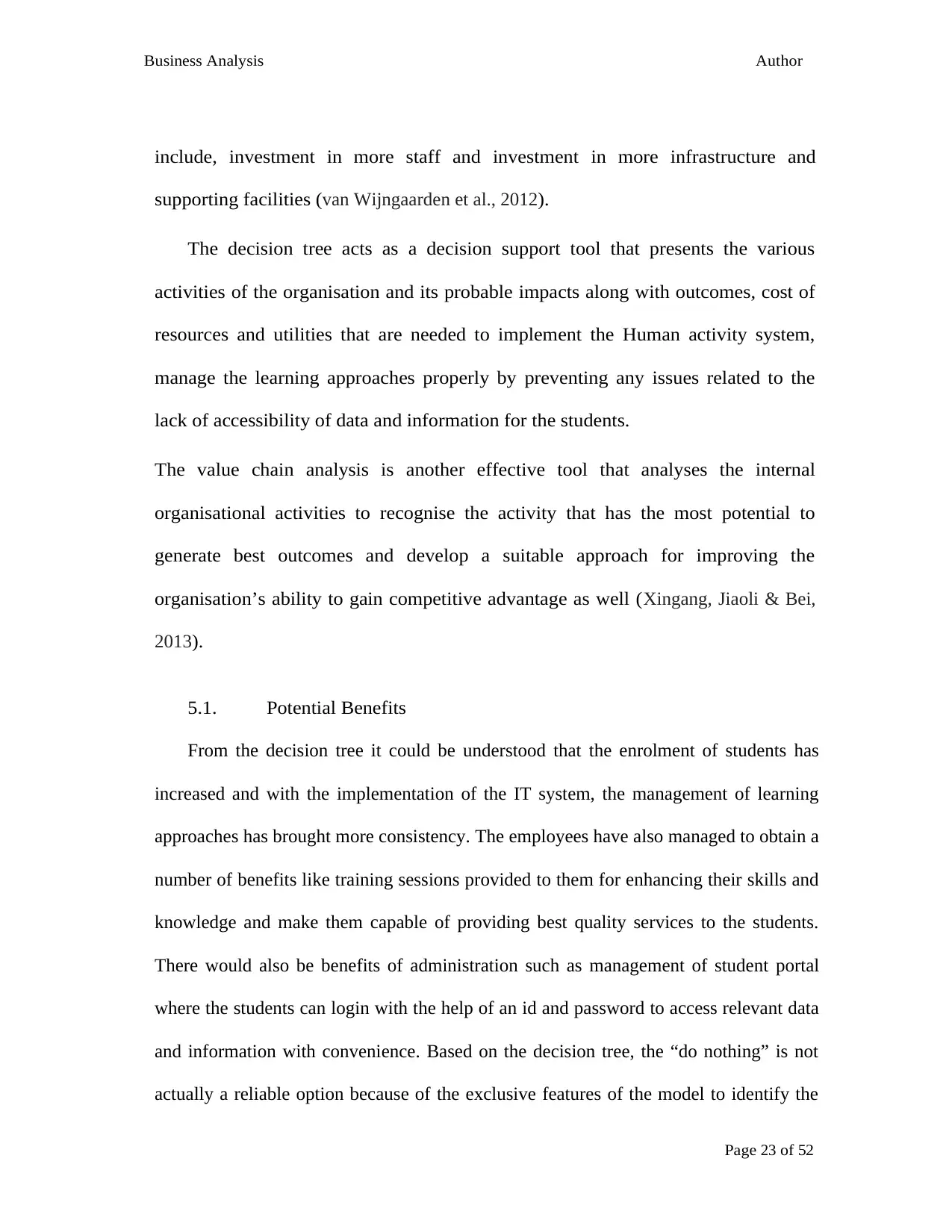
Page 23 of 52
Business Analysis
Report
Author
include, investment in more staff and investment in more infrastructure and
supporting facilities (van Wijngaarden et al., 2012 ).
The decision tree acts as a decision support tool that presents the various
activities of the organisation and its probable impacts along with outcomes, cost of
resources and utilities that are needed to implement the Human activity system,
manage the learning approaches properly by preventing any issues related to the
lack of accessibility of data and information for the students.
The value chain analysis is another effective tool that analyses the internal
organisational activities to recognise the activity that has the most potential to
generate best outcomes and develop a suitable approach for improving the
organisation’s ability to gain competitive advantage as well (Xingang, Jiaoli & Bei,
2013).
5.1. Potential Benefits
From the decision tree it could be understood that the enrolment of students has
increased and with the implementation of the IT system, the management of learning
approaches has brought more consistency. The employees have also managed to obtain a
number of benefits like training sessions provided to them for enhancing their skills and
knowledge and make them capable of providing best quality services to the students.
There would also be benefits of administration such as management of student portal
where the students can login with the help of an id and password to access relevant data
and information with convenience. Based on the decision tree, the “do nothing” is not
actually a reliable option because of the exclusive features of the model to identify the
Business Analysis
Report
Author
include, investment in more staff and investment in more infrastructure and
supporting facilities (van Wijngaarden et al., 2012 ).
The decision tree acts as a decision support tool that presents the various
activities of the organisation and its probable impacts along with outcomes, cost of
resources and utilities that are needed to implement the Human activity system,
manage the learning approaches properly by preventing any issues related to the
lack of accessibility of data and information for the students.
The value chain analysis is another effective tool that analyses the internal
organisational activities to recognise the activity that has the most potential to
generate best outcomes and develop a suitable approach for improving the
organisation’s ability to gain competitive advantage as well (Xingang, Jiaoli & Bei,
2013).
5.1. Potential Benefits
From the decision tree it could be understood that the enrolment of students has
increased and with the implementation of the IT system, the management of learning
approaches has brought more consistency. The employees have also managed to obtain a
number of benefits like training sessions provided to them for enhancing their skills and
knowledge and make them capable of providing best quality services to the students.
There would also be benefits of administration such as management of student portal
where the students can login with the help of an id and password to access relevant data
and information with convenience. Based on the decision tree, the “do nothing” is not
actually a reliable option because of the exclusive features of the model to identify the

Page 24 of 52
Business Analysis
Report
Author
best option that can bring good outcomes along with the various risks that have been
found with the implementation of Human activity system used for the learning
management (Yuan, 2013). The internal business activities have been analysed and this
has also helped to identify the areas that lacked certain strengths, furthermore creating
better scopes and variables for the generation of good amounts of profit and competitive
advantage in business as well. The human resources and financial resources have been
managed well too, because of the monitoring of cost of various activities within the
organisation.
5.2. Risk Assessment
The risk assessment procedure is an integral part of the development of Human
Activity system used for the learning management at Griffith University. It can evaluate
the potential risks associated with the project and even the risks that may hinder the
deriving of projected business outcomes in an effective manner. The risk assessment
technique can help to determine the risks that have been experienced while
implementing the IT system to improve the data and information accessibility and
management of learning courses provided to the students (Aaij et al., 2016).
Business Analysis
Report
Author
best option that can bring good outcomes along with the various risks that have been
found with the implementation of Human activity system used for the learning
management (Yuan, 2013). The internal business activities have been analysed and this
has also helped to identify the areas that lacked certain strengths, furthermore creating
better scopes and variables for the generation of good amounts of profit and competitive
advantage in business as well. The human resources and financial resources have been
managed well too, because of the monitoring of cost of various activities within the
organisation.
5.2. Risk Assessment
The risk assessment procedure is an integral part of the development of Human
Activity system used for the learning management at Griffith University. It can evaluate
the potential risks associated with the project and even the risks that may hinder the
deriving of projected business outcomes in an effective manner. The risk assessment
technique can help to determine the risks that have been experienced while
implementing the IT system to improve the data and information accessibility and
management of learning courses provided to the students (Aaij et al., 2016).

Page 25 of 52
Business Analysis
Report
Author
6. Requirements Analysis
The analysis of requirements is done to check whether all the relevant resources
are available or not for overcoming the issues of Human activity system for the
learning management within the university in Australia. The requirements of
business stakeholders, functional as well as non-functional requirements have been
included here for managing the analysis process in an effective manner.
6.1. Business Requirements
The business requirements include the financial resources, human resources along
with the various assets owned by the organisation to sustain in the business environment.
By preparing and analysing a document report, the requirements are identified to
develop an appropriate strategic plan that can allow the organisation to accomplish the
goals and objectives in business. The MoSCoW technique can be utilised as a
prioritisation technique to analyse the business requirements,. Develop new software and
manage the project properly by establishing a good understanding and relationship with
the stakeholders. This would be beneficial for identifying the needs and requirements of
stakeholders that had been considered as major business requirements to succeed in the
competitive business environment as well (Armstrong & Taylor, 2014). The
requirements of students are needed to be analysed for understanding what can satisfy
them and even develop the learning and course programs according to their needs and
preferences.
Business Analysis
Report
Author
6. Requirements Analysis
The analysis of requirements is done to check whether all the relevant resources
are available or not for overcoming the issues of Human activity system for the
learning management within the university in Australia. The requirements of
business stakeholders, functional as well as non-functional requirements have been
included here for managing the analysis process in an effective manner.
6.1. Business Requirements
The business requirements include the financial resources, human resources along
with the various assets owned by the organisation to sustain in the business environment.
By preparing and analysing a document report, the requirements are identified to
develop an appropriate strategic plan that can allow the organisation to accomplish the
goals and objectives in business. The MoSCoW technique can be utilised as a
prioritisation technique to analyse the business requirements,. Develop new software and
manage the project properly by establishing a good understanding and relationship with
the stakeholders. This would be beneficial for identifying the needs and requirements of
stakeholders that had been considered as major business requirements to succeed in the
competitive business environment as well (Armstrong & Taylor, 2014). The
requirements of students are needed to be analysed for understanding what can satisfy
them and even develop the learning and course programs according to their needs and
preferences.
Secure Best Marks with AI Grader
Need help grading? Try our AI Grader for instant feedback on your assignments.

Page 26 of 52
Business Analysis
Report
Author
6.2. Stakeholder Requirements for the Top Business Requirement
From the MoSCoW technique, it is quite clear that the requirements of the students
have been considered as the most important that are needed to be fulfilled to become
successful in the market. The requirements of faculties and academicians are needed to
be fulfilled as well for ensuring that they allow the students to obtain relevant materials
and information regarding their project as well as make them progress in their career
with perfection.
The most important business requirement is to improve the infrastructure of the
organisation, which can be done by making necessary investments and by implementing
newer and advanced technologies. This can improve the way higher education facilities
are provided to students and furthermore ensure satisfaction of students effectively too
(Burke, 2013).
6.3. Functional Requirements
The functional requirements of the organisation are implementation of advanced IT
systems to management and processing of data, make calculations and allow the
organisation to use its technical expertise for the achievement of goals and objectives
properly. The functional requirements also include the requirements of stakeholders such
as accessibility to relevant information for studying and learning the course or degree
program that can allow them progress in their career (Card, 2016).
6.4. Non-functional Requirements
The non-functional requirements are the environmental factors that can create an
Business Analysis
Report
Author
6.2. Stakeholder Requirements for the Top Business Requirement
From the MoSCoW technique, it is quite clear that the requirements of the students
have been considered as the most important that are needed to be fulfilled to become
successful in the market. The requirements of faculties and academicians are needed to
be fulfilled as well for ensuring that they allow the students to obtain relevant materials
and information regarding their project as well as make them progress in their career
with perfection.
The most important business requirement is to improve the infrastructure of the
organisation, which can be done by making necessary investments and by implementing
newer and advanced technologies. This can improve the way higher education facilities
are provided to students and furthermore ensure satisfaction of students effectively too
(Burke, 2013).
6.3. Functional Requirements
The functional requirements of the organisation are implementation of advanced IT
systems to management and processing of data, make calculations and allow the
organisation to use its technical expertise for the achievement of goals and objectives
properly. The functional requirements also include the requirements of stakeholders such
as accessibility to relevant information for studying and learning the course or degree
program that can allow them progress in their career (Card, 2016).
6.4. Non-functional Requirements
The non-functional requirements are the environmental factors that can create an
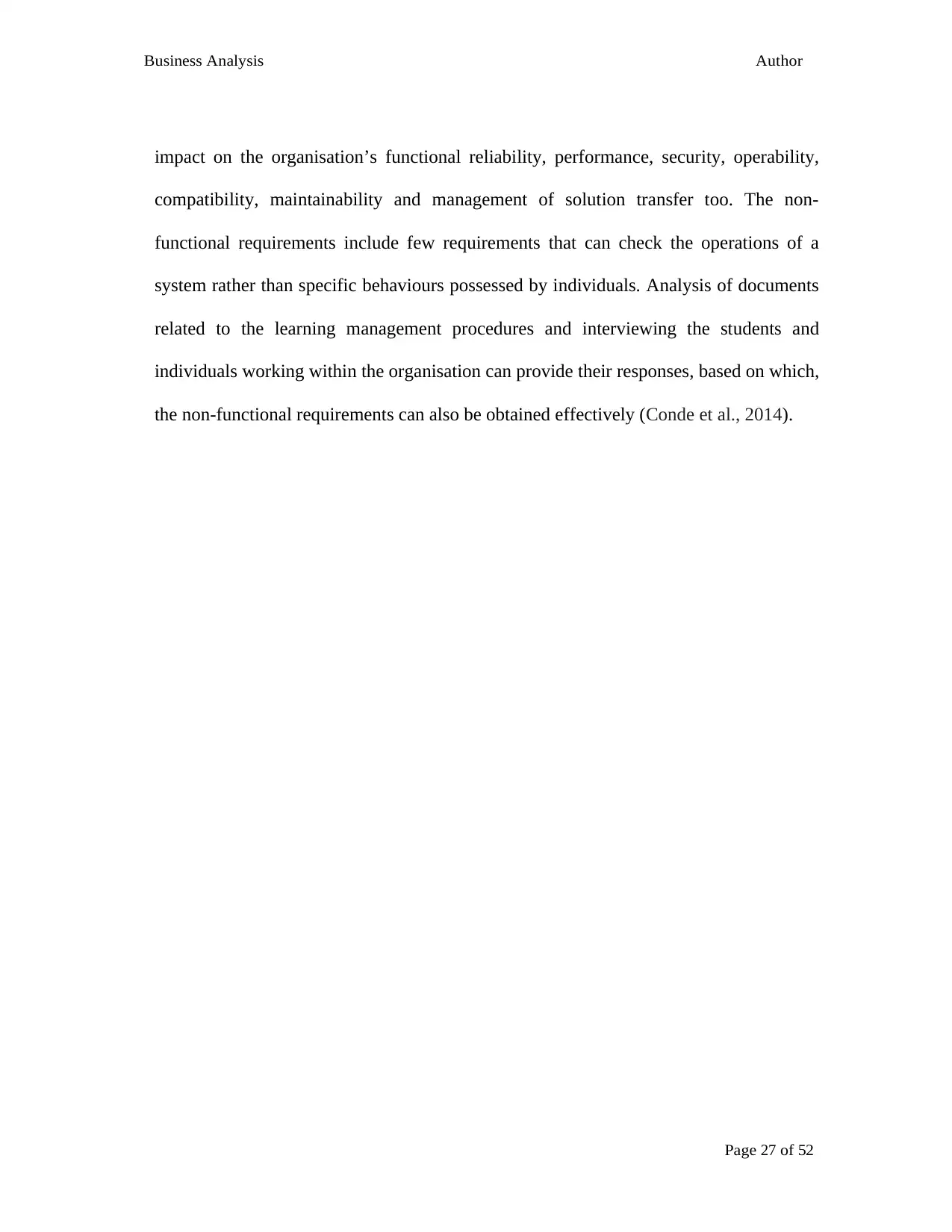
Page 27 of 52
Business Analysis
Report
Author
impact on the organisation’s functional reliability, performance, security, operability,
compatibility, maintainability and management of solution transfer too. The non-
functional requirements include few requirements that can check the operations of a
system rather than specific behaviours possessed by individuals. Analysis of documents
related to the learning management procedures and interviewing the students and
individuals working within the organisation can provide their responses, based on which,
the non-functional requirements can also be obtained effectively (Conde et al., 2014).
Business Analysis
Report
Author
impact on the organisation’s functional reliability, performance, security, operability,
compatibility, maintainability and management of solution transfer too. The non-
functional requirements include few requirements that can check the operations of a
system rather than specific behaviours possessed by individuals. Analysis of documents
related to the learning management procedures and interviewing the students and
individuals working within the organisation can provide their responses, based on which,
the non-functional requirements can also be obtained effectively (Conde et al., 2014).
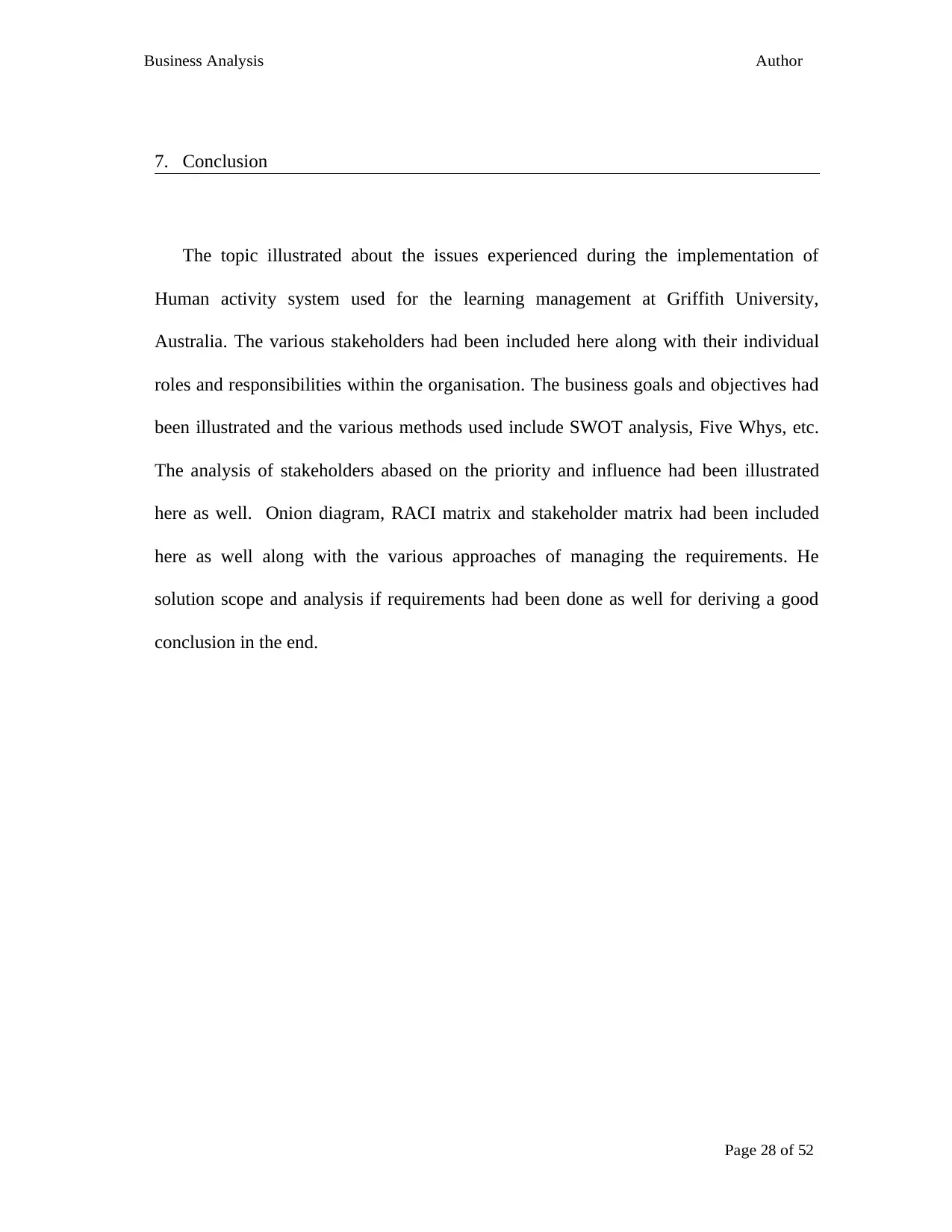
Page 28 of 52
Business Analysis
Report
Author
7. Conclusion
The topic illustrated about the issues experienced during the implementation of
Human activity system used for the learning management at Griffith University,
Australia. The various stakeholders had been included here along with their individual
roles and responsibilities within the organisation. The business goals and objectives had
been illustrated and the various methods used include SWOT analysis, Five Whys, etc.
The analysis of stakeholders abased on the priority and influence had been illustrated
here as well. Onion diagram, RACI matrix and stakeholder matrix had been included
here as well along with the various approaches of managing the requirements. He
solution scope and analysis if requirements had been done as well for deriving a good
conclusion in the end.
Business Analysis
Report
Author
7. Conclusion
The topic illustrated about the issues experienced during the implementation of
Human activity system used for the learning management at Griffith University,
Australia. The various stakeholders had been included here along with their individual
roles and responsibilities within the organisation. The business goals and objectives had
been illustrated and the various methods used include SWOT analysis, Five Whys, etc.
The analysis of stakeholders abased on the priority and influence had been illustrated
here as well. Onion diagram, RACI matrix and stakeholder matrix had been included
here as well along with the various approaches of managing the requirements. He
solution scope and analysis if requirements had been done as well for deriving a good
conclusion in the end.
Paraphrase This Document
Need a fresh take? Get an instant paraphrase of this document with our AI Paraphraser
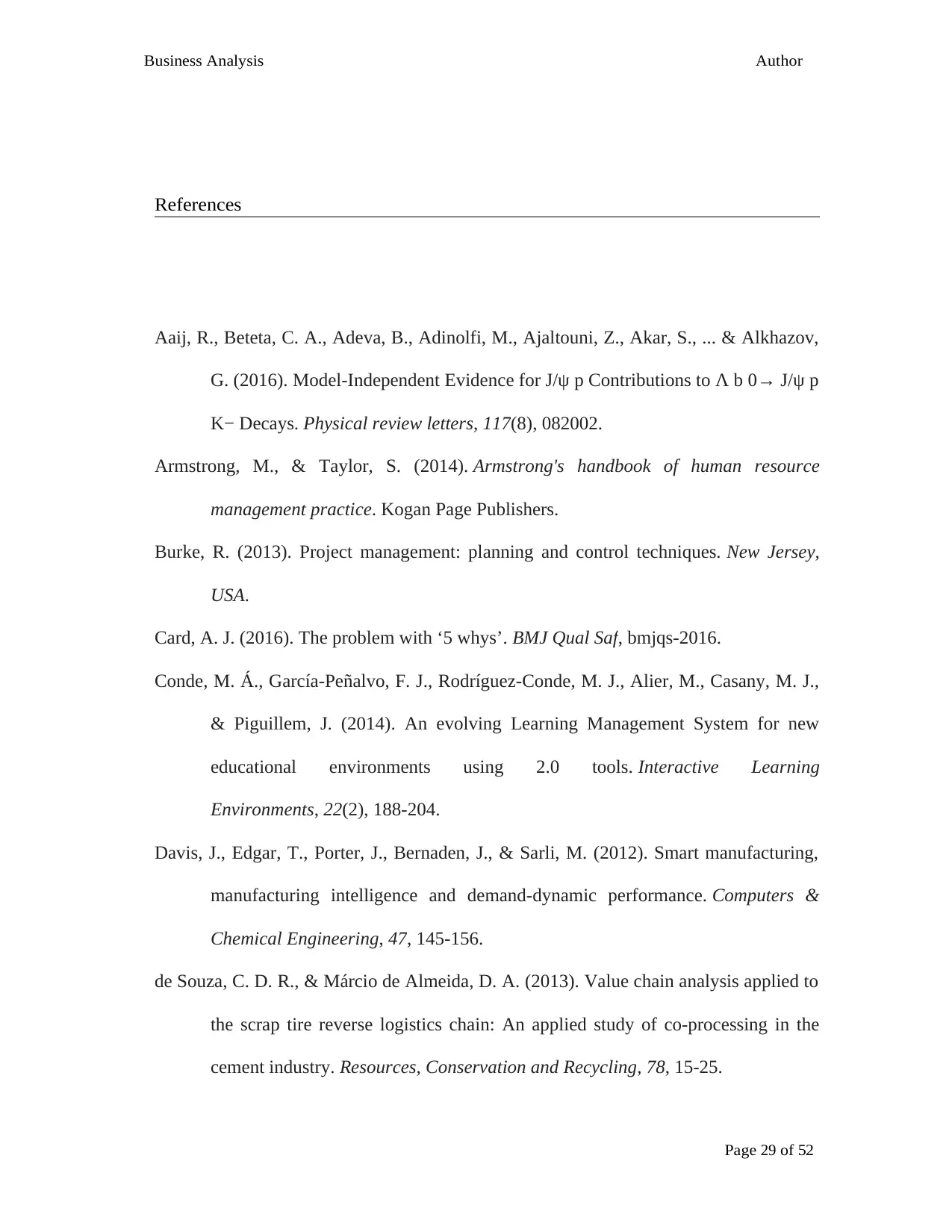
Page 29 of 52
Business Analysis
Report
Author
References
Aaij, R., Beteta, C. A., Adeva, B., Adinolfi, M., Ajaltouni, Z., Akar, S., ... & Alkhazov,
G. (2016). Model-Independent Evidence for J/ψ p Contributions to Λ b 0→ J/ψ p
K− Decays. Physical review letters, 117(8), 082002.
Armstrong, M., & Taylor, S. (2014). Armstrong's handbook of human resource
management practice. Kogan Page Publishers.
Burke, R. (2013). Project management: planning and control techniques. New Jersey,
USA.
Card, A. J. (2016). The problem with ‘5 whys’. BMJ Qual Saf, bmjqs-2016.
Conde, M. Á., García-Peñalvo, F. J., Rodríguez-Conde, M. J., Alier, M., Casany, M. J.,
& Piguillem, J. (2014). An evolving Learning Management System for new
educational environments using 2.0 tools. Interactive Learning
Environments, 22(2), 188-204.
Davis, J., Edgar, T., Porter, J., Bernaden, J., & Sarli, M. (2012). Smart manufacturing,
manufacturing intelligence and demand-dynamic performance. Computers &
Chemical Engineering, 47, 145-156.
de Souza, C. D. R., & Márcio de Almeida, D. A. (2013). Value chain analysis applied to
the scrap tire reverse logistics chain: An applied study of co-processing in the
cement industry. Resources, Conservation and Recycling, 78, 15-25.
Business Analysis
Report
Author
References
Aaij, R., Beteta, C. A., Adeva, B., Adinolfi, M., Ajaltouni, Z., Akar, S., ... & Alkhazov,
G. (2016). Model-Independent Evidence for J/ψ p Contributions to Λ b 0→ J/ψ p
K− Decays. Physical review letters, 117(8), 082002.
Armstrong, M., & Taylor, S. (2014). Armstrong's handbook of human resource
management practice. Kogan Page Publishers.
Burke, R. (2013). Project management: planning and control techniques. New Jersey,
USA.
Card, A. J. (2016). The problem with ‘5 whys’. BMJ Qual Saf, bmjqs-2016.
Conde, M. Á., García-Peñalvo, F. J., Rodríguez-Conde, M. J., Alier, M., Casany, M. J.,
& Piguillem, J. (2014). An evolving Learning Management System for new
educational environments using 2.0 tools. Interactive Learning
Environments, 22(2), 188-204.
Davis, J., Edgar, T., Porter, J., Bernaden, J., & Sarli, M. (2012). Smart manufacturing,
manufacturing intelligence and demand-dynamic performance. Computers &
Chemical Engineering, 47, 145-156.
de Souza, C. D. R., & Márcio de Almeida, D. A. (2013). Value chain analysis applied to
the scrap tire reverse logistics chain: An applied study of co-processing in the
cement industry. Resources, Conservation and Recycling, 78, 15-25.

Page 30 of 52
Business Analysis
Report
Author
Department of Education and Training, (2011). Enrolments at Qld State Schools, by
Year Level. Education Queensland. Retrieved September 2016, from
http://education.qld.gov.au/schools/statisticsdocs/enrol-yrlevel-2007-2011.pdf
Engeström, Y. (2014). Activity theory and learning at work. In Tätigkeit-Aneignung-
Bildung (pp. 67-96). Springer Fachmedien Wiesbaden.
Fraser, R. (2012). Half Cohort, Half Truths. National Tertiary Education Union.
Retrieved 28 September, from http://www.nteu.org.au/uq/article/Half-Cohort,-
Half-Truths-13076
Goetsch, D. L., & Davis, S. B. (2014). Quality management for organizational
excellence. Upper Saddle River, NJ: pearson.
Griffith, B. E. (2012). Immersed boundary model of aortic heart valve dynamics with
physiological driving and loading conditions. International Journal for
Numerical Methods in Biomedical Engineering, 28(3), 317-345.
Hammond, J. S., Keeney, R. L., & Raiffa, H. (2015). Smart choices: A practical guide to
making better decisions. Harvard Business Review Press.
Hellweg, S., & i Canals, L. M. (2014). Emerging approaches, challenges and
opportunities in life cycle assessment. Science, 344(6188), 1109-1113.
Hewitt-Taylor, J. (2012). Identifying, analysing and solving problems in
practice. Nursing Standard, 26(40), 35-41.
Hollensen, S. (2015). Marketing management: A relationship approach. Pearson
Education.
Hu, Q., & Li, F. (2013). Hardware design of smart home energy management system
with dynamic price response. IEEE Transactions on Smart grid, 4(4), 1878-
Business Analysis
Report
Author
Department of Education and Training, (2011). Enrolments at Qld State Schools, by
Year Level. Education Queensland. Retrieved September 2016, from
http://education.qld.gov.au/schools/statisticsdocs/enrol-yrlevel-2007-2011.pdf
Engeström, Y. (2014). Activity theory and learning at work. In Tätigkeit-Aneignung-
Bildung (pp. 67-96). Springer Fachmedien Wiesbaden.
Fraser, R. (2012). Half Cohort, Half Truths. National Tertiary Education Union.
Retrieved 28 September, from http://www.nteu.org.au/uq/article/Half-Cohort,-
Half-Truths-13076
Goetsch, D. L., & Davis, S. B. (2014). Quality management for organizational
excellence. Upper Saddle River, NJ: pearson.
Griffith, B. E. (2012). Immersed boundary model of aortic heart valve dynamics with
physiological driving and loading conditions. International Journal for
Numerical Methods in Biomedical Engineering, 28(3), 317-345.
Hammond, J. S., Keeney, R. L., & Raiffa, H. (2015). Smart choices: A practical guide to
making better decisions. Harvard Business Review Press.
Hellweg, S., & i Canals, L. M. (2014). Emerging approaches, challenges and
opportunities in life cycle assessment. Science, 344(6188), 1109-1113.
Hewitt-Taylor, J. (2012). Identifying, analysing and solving problems in
practice. Nursing Standard, 26(40), 35-41.
Hollensen, S. (2015). Marketing management: A relationship approach. Pearson
Education.
Hu, Q., & Li, F. (2013). Hardware design of smart home energy management system
with dynamic price response. IEEE Transactions on Smart grid, 4(4), 1878-
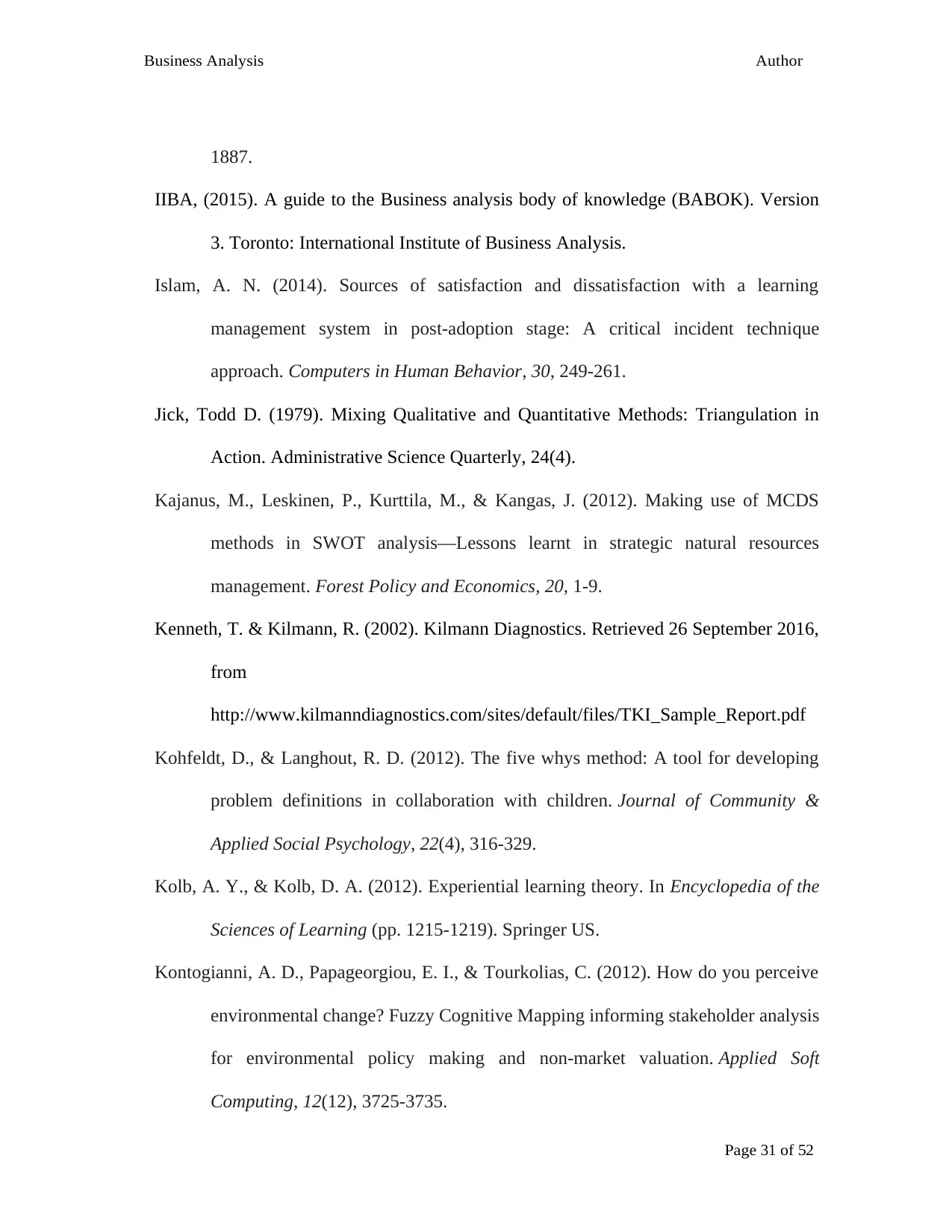
Page 31 of 52
Business Analysis
Report
Author
1887.
IIBA, (2015). A guide to the Business analysis body of knowledge (BABOK). Version
3. Toronto: International Institute of Business Analysis.
Islam, A. N. (2014). Sources of satisfaction and dissatisfaction with a learning
management system in post-adoption stage: A critical incident technique
approach. Computers in Human Behavior, 30, 249-261.
Jick, Todd D. (1979). Mixing Qualitative and Quantitative Methods: Triangulation in
Action. Administrative Science Quarterly, 24(4).
Kajanus, M., Leskinen, P., Kurttila, M., & Kangas, J. (2012). Making use of MCDS
methods in SWOT analysis—Lessons learnt in strategic natural resources
management. Forest Policy and Economics, 20, 1-9.
Kenneth, T. & Kilmann, R. (2002). Kilmann Diagnostics. Retrieved 26 September 2016,
from
http://www.kilmanndiagnostics.com/sites/default/files/TKI_Sample_Report.pdf
Kohfeldt, D., & Langhout, R. D. (2012). The five whys method: A tool for developing
problem definitions in collaboration with children. Journal of Community &
Applied Social Psychology, 22(4), 316-329.
Kolb, A. Y., & Kolb, D. A. (2012). Experiential learning theory. In Encyclopedia of the
Sciences of Learning (pp. 1215-1219). Springer US.
Kontogianni, A. D., Papageorgiou, E. I., & Tourkolias, C. (2012). How do you perceive
environmental change? Fuzzy Cognitive Mapping informing stakeholder analysis
for environmental policy making and non-market valuation. Applied Soft
Computing, 12(12), 3725-3735.
Business Analysis
Report
Author
1887.
IIBA, (2015). A guide to the Business analysis body of knowledge (BABOK). Version
3. Toronto: International Institute of Business Analysis.
Islam, A. N. (2014). Sources of satisfaction and dissatisfaction with a learning
management system in post-adoption stage: A critical incident technique
approach. Computers in Human Behavior, 30, 249-261.
Jick, Todd D. (1979). Mixing Qualitative and Quantitative Methods: Triangulation in
Action. Administrative Science Quarterly, 24(4).
Kajanus, M., Leskinen, P., Kurttila, M., & Kangas, J. (2012). Making use of MCDS
methods in SWOT analysis—Lessons learnt in strategic natural resources
management. Forest Policy and Economics, 20, 1-9.
Kenneth, T. & Kilmann, R. (2002). Kilmann Diagnostics. Retrieved 26 September 2016,
from
http://www.kilmanndiagnostics.com/sites/default/files/TKI_Sample_Report.pdf
Kohfeldt, D., & Langhout, R. D. (2012). The five whys method: A tool for developing
problem definitions in collaboration with children. Journal of Community &
Applied Social Psychology, 22(4), 316-329.
Kolb, A. Y., & Kolb, D. A. (2012). Experiential learning theory. In Encyclopedia of the
Sciences of Learning (pp. 1215-1219). Springer US.
Kontogianni, A. D., Papageorgiou, E. I., & Tourkolias, C. (2012). How do you perceive
environmental change? Fuzzy Cognitive Mapping informing stakeholder analysis
for environmental policy making and non-market valuation. Applied Soft
Computing, 12(12), 3725-3735.
Secure Best Marks with AI Grader
Need help grading? Try our AI Grader for instant feedback on your assignments.

Page 32 of 52
Business Analysis
Report
Author
Laudon, K. C., & Laudon, J. P. (2016). Management information system. Pearson
Education India.
Lienert, J., Schnetzer, F., & Ingold, K. (2013). Stakeholder analysis combined with
social network analysis provides fine-grained insights into water infrastructure
planning processes. Journal of environmental management, 125, 134-148.
Mannarini, T., & Fedi, A. (2012). Persisting or withdrawing? An insight into the
psychosocial processes underlying sustained engagement. Journal of Community
& Applied Social Psychology, 22(4), 300-315.
Mbow, C., Neely, C., & Dobie, P. (2015). How can an integrated landscape approach
contribute to the implementation of the Sustainable Development Goals (SDGs)
and advance climate-smart objectives?. Climate-Smart Landscapes:
Multifunctionality in Practice.
Miller, H. G., & Mork, P. (2013). From data to decisions: a value chain for big data. IT
Professional, 15(1), 57-59.
Missonier, S., & Loufrani-Fedida, S. (2014). Stakeholder analysis and engagement in
projects: From stakeholder relational perspective to stakeholder relational
ontology. International Journal of Project Management, 32(7), 1108-1122.
Satzinger, J., Jackson, R., & Burd, S. (2012). Systems Analysis and Design in a
Changing World (6th Ed.). Boston, MA: Course Technology, Cengage Learning.
Serrat, O. (2017). The five whys technique. In Knowledge Solutions (pp. 307-310).
Springer Singapore.
Seuring, S. (2013). A review of modeling approaches for sustainable supply chain
management. Decision support systems, 54(4), 1513-1520.
Business Analysis
Report
Author
Laudon, K. C., & Laudon, J. P. (2016). Management information system. Pearson
Education India.
Lienert, J., Schnetzer, F., & Ingold, K. (2013). Stakeholder analysis combined with
social network analysis provides fine-grained insights into water infrastructure
planning processes. Journal of environmental management, 125, 134-148.
Mannarini, T., & Fedi, A. (2012). Persisting or withdrawing? An insight into the
psychosocial processes underlying sustained engagement. Journal of Community
& Applied Social Psychology, 22(4), 300-315.
Mbow, C., Neely, C., & Dobie, P. (2015). How can an integrated landscape approach
contribute to the implementation of the Sustainable Development Goals (SDGs)
and advance climate-smart objectives?. Climate-Smart Landscapes:
Multifunctionality in Practice.
Miller, H. G., & Mork, P. (2013). From data to decisions: a value chain for big data. IT
Professional, 15(1), 57-59.
Missonier, S., & Loufrani-Fedida, S. (2014). Stakeholder analysis and engagement in
projects: From stakeholder relational perspective to stakeholder relational
ontology. International Journal of Project Management, 32(7), 1108-1122.
Satzinger, J., Jackson, R., & Burd, S. (2012). Systems Analysis and Design in a
Changing World (6th Ed.). Boston, MA: Course Technology, Cengage Learning.
Serrat, O. (2017). The five whys technique. In Knowledge Solutions (pp. 307-310).
Springer Singapore.
Seuring, S. (2013). A review of modeling approaches for sustainable supply chain
management. Decision support systems, 54(4), 1513-1520.
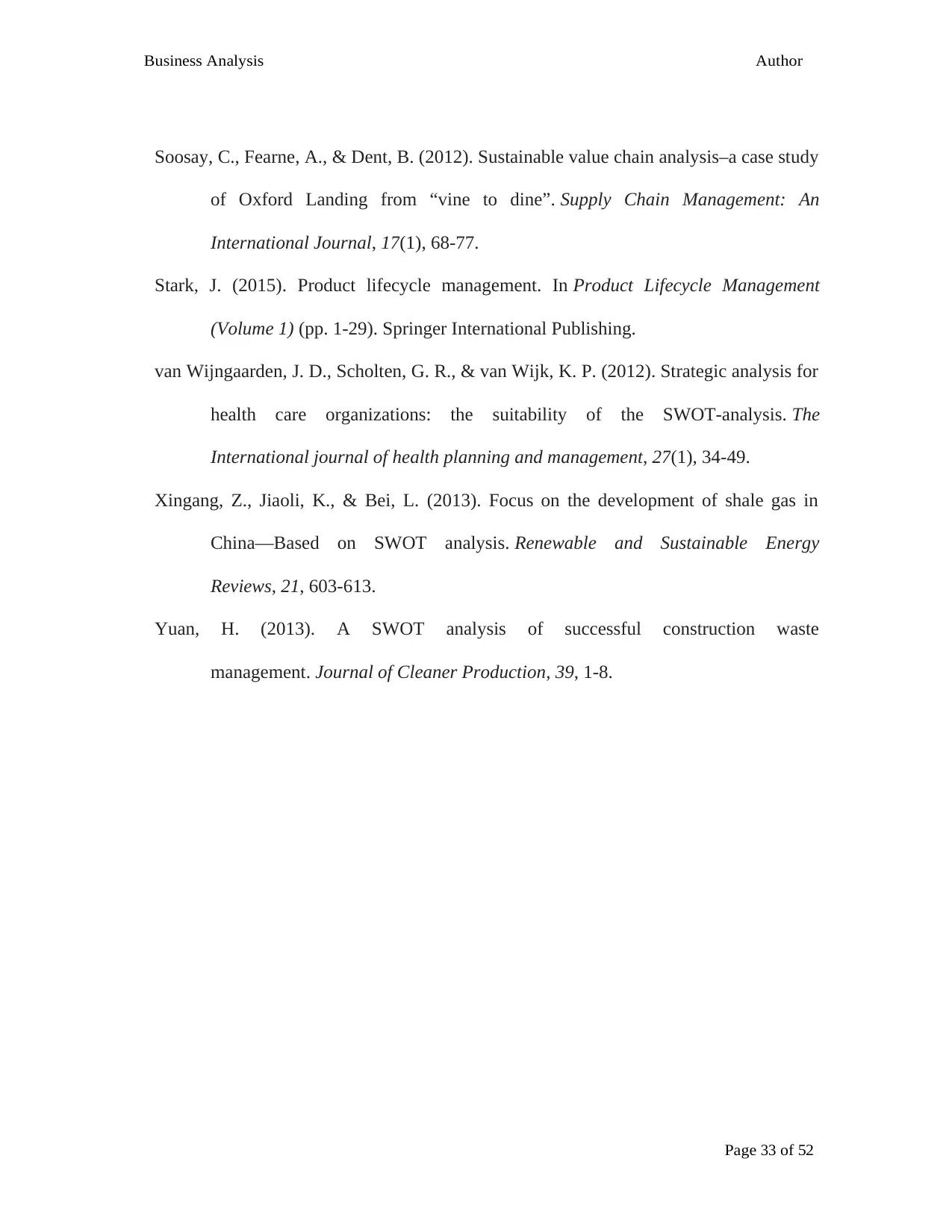
Page 33 of 52
Business Analysis
Report
Author
Soosay, C., Fearne, A., & Dent, B. (2012). Sustainable value chain analysis–a case study
of Oxford Landing from “vine to dine”. Supply Chain Management: An
International Journal, 17(1), 68-77.
Stark, J. (2015). Product lifecycle management. In Product Lifecycle Management
(Volume 1) (pp. 1-29). Springer International Publishing.
van Wijngaarden, J. D., Scholten, G. R., & van Wijk, K. P. (2012). Strategic analysis for
health care organizations: the suitability of the SWOT‐analysis. The
International journal of health planning and management, 27(1), 34-49.
Xingang, Z., Jiaoli, K., & Bei, L. (2013). Focus on the development of shale gas in
China—Based on SWOT analysis. Renewable and Sustainable Energy
Reviews, 21, 603-613.
Yuan, H. (2013). A SWOT analysis of successful construction waste
management. Journal of Cleaner Production, 39, 1-8.
Business Analysis
Report
Author
Soosay, C., Fearne, A., & Dent, B. (2012). Sustainable value chain analysis–a case study
of Oxford Landing from “vine to dine”. Supply Chain Management: An
International Journal, 17(1), 68-77.
Stark, J. (2015). Product lifecycle management. In Product Lifecycle Management
(Volume 1) (pp. 1-29). Springer International Publishing.
van Wijngaarden, J. D., Scholten, G. R., & van Wijk, K. P. (2012). Strategic analysis for
health care organizations: the suitability of the SWOT‐analysis. The
International journal of health planning and management, 27(1), 34-49.
Xingang, Z., Jiaoli, K., & Bei, L. (2013). Focus on the development of shale gas in
China—Based on SWOT analysis. Renewable and Sustainable Energy
Reviews, 21, 603-613.
Yuan, H. (2013). A SWOT analysis of successful construction waste
management. Journal of Cleaner Production, 39, 1-8.

Page 34 of 52
Business Analysis
Report
Author
Appendices
This section holds a collection of relevant diagrams and analysis techniques used
for the elaboration and discussion of the topic sections in the above report.
Appendix A. List of Goals & Objectives
The goals and objectives that are needed to be achieved have been demonstrated
within the appendix.
Table 2. Goals and Objectives
Goals:
Goal 1 The most important goal is to manage accessibility of course materials
consisting of important information for the students to progress in their career.
Goal 2 Another goal of the organisation, i.e., Griffith University is to prevent the
risks that are associated with the issues of Human Activity system used for the
Objectives:
Objective 1 The first and foremost objective is to implement an effective IT system
Objective 2 To provide training sessions to workers of the organisation for
enhancing their skills and abilities and make them deliver the best quality services
Appendix B. SMART Analysis
Business Analysis
Report
Author
Appendices
This section holds a collection of relevant diagrams and analysis techniques used
for the elaboration and discussion of the topic sections in the above report.
Appendix A. List of Goals & Objectives
The goals and objectives that are needed to be achieved have been demonstrated
within the appendix.
Table 2. Goals and Objectives
Goals:
Goal 1 The most important goal is to manage accessibility of course materials
consisting of important information for the students to progress in their career.
Goal 2 Another goal of the organisation, i.e., Griffith University is to prevent the
risks that are associated with the issues of Human Activity system used for the
Objectives:
Objective 1 The first and foremost objective is to implement an effective IT system
Objective 2 To provide training sessions to workers of the organisation for
enhancing their skills and abilities and make them deliver the best quality services
Appendix B. SMART Analysis
Paraphrase This Document
Need a fresh take? Get an instant paraphrase of this document with our AI Paraphraser

Page 35 of 52
Business Analysis
Report
Author
The SMART analysis has been done for identifying the specific, measurable,
achievable or agreed upon, realistic and time bound objectives that will be achieved
by the organisation to become sustainable within the competitive business
environment.
Table 3. SMART Analysis
Objective: Objective 1
Specific The specific objective is to ensure that flexibility if maintained
all across the degree programs provided to the students at GriffithMeasurable To measure the number of students who have enrolled for the
courses and obtain a degree from the University (DepartmentAchievable To introduce an effective system that can deliver more
educational opportunities for the students to gain a degree
Relevant The realistic objective is to implement an online learning system
and opening a student portal where the students can login with
their password and user name to gain access to course materialsTime Bounded To enhance the quality of services delivered for attracting and
retaining the students all over Australia and even keep them
Appendix C. SWOT Analysis
The SWOT analysis is an effective tool used for identifying the changes that can be
made based on the strengths, weaknesses, opportunities and threats. The weaknesses
show the areas where the organisation lacked certain things whereas the threats are
mitigated prior to the occurrence of any issues and based on that necessary changes
can be made for making the organisation deliver the best quality services to the
Business Analysis
Report
Author
The SMART analysis has been done for identifying the specific, measurable,
achievable or agreed upon, realistic and time bound objectives that will be achieved
by the organisation to become sustainable within the competitive business
environment.
Table 3. SMART Analysis
Objective: Objective 1
Specific The specific objective is to ensure that flexibility if maintained
all across the degree programs provided to the students at GriffithMeasurable To measure the number of students who have enrolled for the
courses and obtain a degree from the University (DepartmentAchievable To introduce an effective system that can deliver more
educational opportunities for the students to gain a degree
Relevant The realistic objective is to implement an online learning system
and opening a student portal where the students can login with
their password and user name to gain access to course materialsTime Bounded To enhance the quality of services delivered for attracting and
retaining the students all over Australia and even keep them
Appendix C. SWOT Analysis
The SWOT analysis is an effective tool used for identifying the changes that can be
made based on the strengths, weaknesses, opportunities and threats. The weaknesses
show the areas where the organisation lacked certain things whereas the threats are
mitigated prior to the occurrence of any issues and based on that necessary changes
can be made for making the organisation deliver the best quality services to the
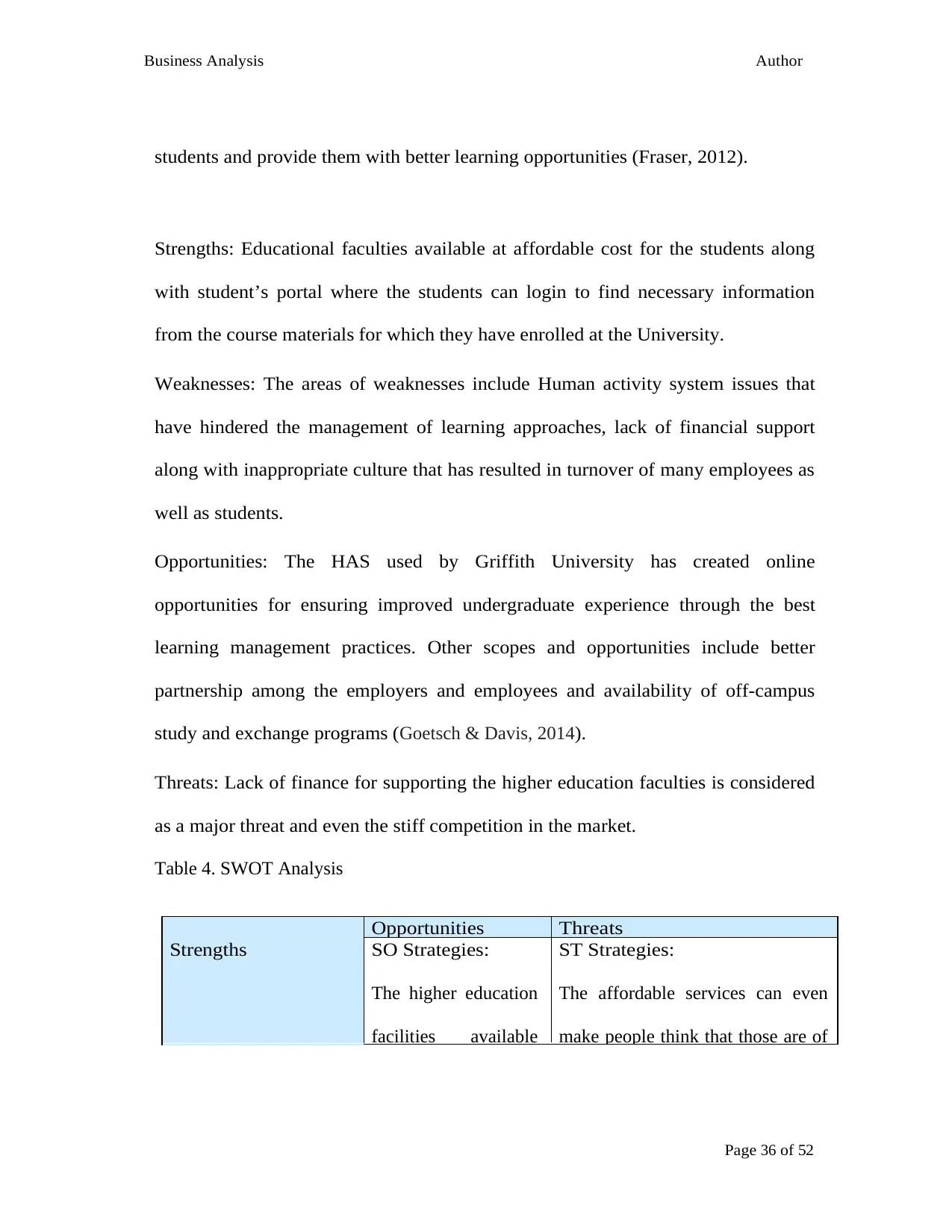
Page 36 of 52
Business Analysis
Report
Author
students and provide them with better learning opportunities (Fraser, 2012).
Strengths: Educational faculties available at affordable cost for the students along
with student’s portal where the students can login to find necessary information
from the course materials for which they have enrolled at the University.
Weaknesses: The areas of weaknesses include Human activity system issues that
have hindered the management of learning approaches, lack of financial support
along with inappropriate culture that has resulted in turnover of many employees as
well as students.
Opportunities: The HAS used by Griffith University has created online
opportunities for ensuring improved undergraduate experience through the best
learning management practices. Other scopes and opportunities include better
partnership among the employers and employees and availability of off-campus
study and exchange programs (Goetsch & Davis, 2014).
Threats: Lack of finance for supporting the higher education faculties is considered
as a major threat and even the stiff competition in the market.
Table 4. SWOT Analysis
Opportunities Threats
Strengths SO Strategies:
The higher education
facilities available
ST Strategies:
The affordable services can even
make people think that those are of
Business Analysis
Report
Author
students and provide them with better learning opportunities (Fraser, 2012).
Strengths: Educational faculties available at affordable cost for the students along
with student’s portal where the students can login to find necessary information
from the course materials for which they have enrolled at the University.
Weaknesses: The areas of weaknesses include Human activity system issues that
have hindered the management of learning approaches, lack of financial support
along with inappropriate culture that has resulted in turnover of many employees as
well as students.
Opportunities: The HAS used by Griffith University has created online
opportunities for ensuring improved undergraduate experience through the best
learning management practices. Other scopes and opportunities include better
partnership among the employers and employees and availability of off-campus
study and exchange programs (Goetsch & Davis, 2014).
Threats: Lack of finance for supporting the higher education faculties is considered
as a major threat and even the stiff competition in the market.
Table 4. SWOT Analysis
Opportunities Threats
Strengths SO Strategies:
The higher education
facilities available
ST Strategies:
The affordable services can even
make people think that those are of

Page 37 of 52
Business Analysis
Report
Author
Weaknesses WO Strategies:
Lack of financial can
create scopes for
investors to invest
WT Strategies:
The high competition can even
result in higher turnover of students
and staffs
Appendix D. The 5 Whys
Statement of the Problem: Why is the problem happening?
Table 5. Five Whys Technique applied to Problem 1, 2, 3 (for example)
Problem 1 Problem 2 Problem 3
Why? Lesser options of
flexible course
Less time available
for completion of
Why is the problem
happening?
Why? The organisation’s
incapability to attract
new students and retain
Lack of financial and
human resources to
manage services properly
Inappropriate
management of human
and financial resources
Why? Poor access to data
and information
Creates difficulties to
study the course
appropriately
IT system problems
Why? The numbers of
students who have
enrolled are quite
Human activity
system failed to
identify the needs
Inability to access data and
information
Why? Many courses are
not available
Poor flexible options
for learning
Problems related t the
management of learning for
Appendix E. Key Stakeholders’ Role, Authority, Interest and Influence
Some explanation
Business Analysis
Report
Author
Weaknesses WO Strategies:
Lack of financial can
create scopes for
investors to invest
WT Strategies:
The high competition can even
result in higher turnover of students
and staffs
Appendix D. The 5 Whys
Statement of the Problem: Why is the problem happening?
Table 5. Five Whys Technique applied to Problem 1, 2, 3 (for example)
Problem 1 Problem 2 Problem 3
Why? Lesser options of
flexible course
Less time available
for completion of
Why is the problem
happening?
Why? The organisation’s
incapability to attract
new students and retain
Lack of financial and
human resources to
manage services properly
Inappropriate
management of human
and financial resources
Why? Poor access to data
and information
Creates difficulties to
study the course
appropriately
IT system problems
Why? The numbers of
students who have
enrolled are quite
Human activity
system failed to
identify the needs
Inability to access data and
information
Why? Many courses are
not available
Poor flexible options
for learning
Problems related t the
management of learning for
Appendix E. Key Stakeholders’ Role, Authority, Interest and Influence
Some explanation
Secure Best Marks with AI Grader
Need help grading? Try our AI Grader for instant feedback on your assignments.
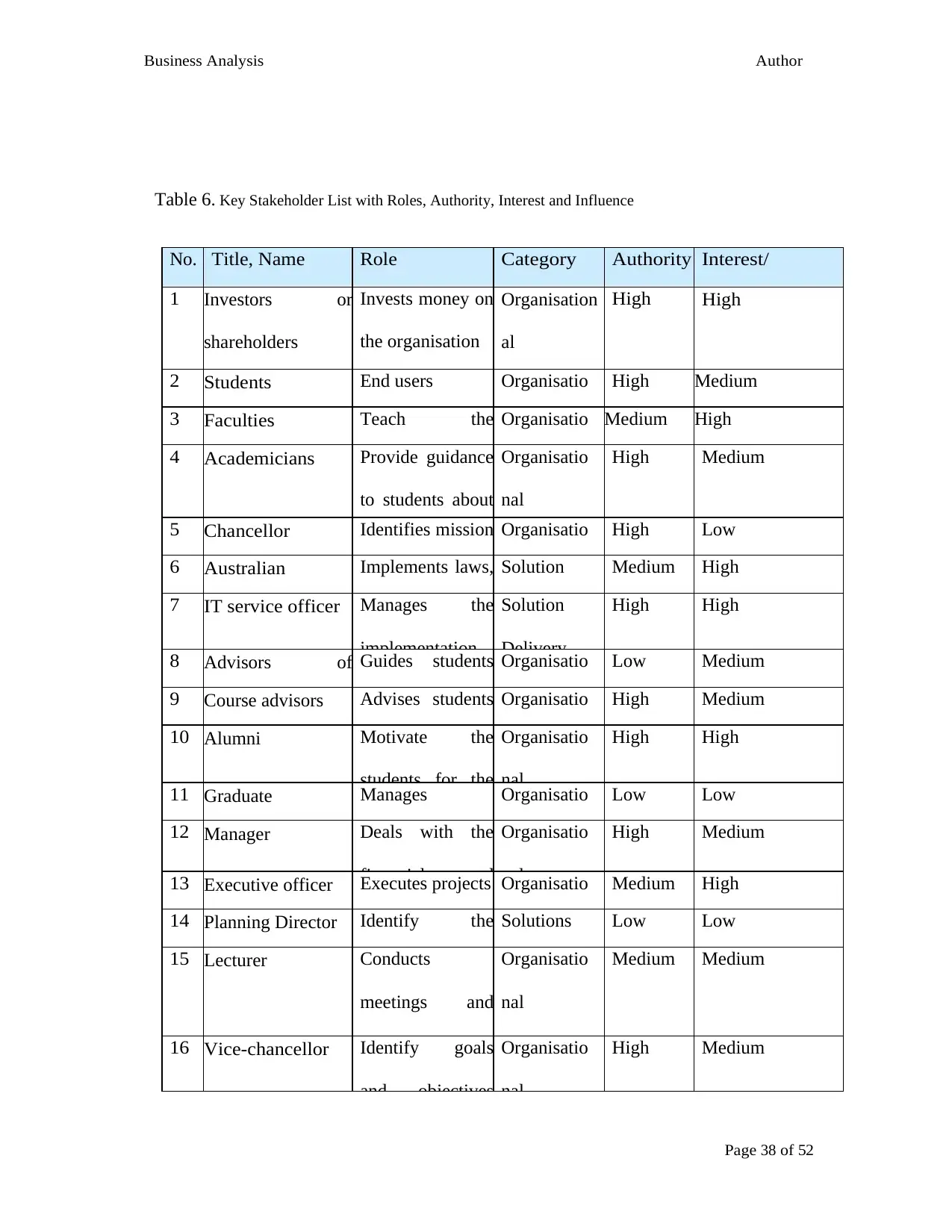
Page 38 of 52
Business Analysis
Report
Author
Table 6. Key Stakeholder List with Roles, Authority, Interest and Influence
No. Title, Name Role Category Authority Interest/
Influence1 Investors or
shareholders
Invests money on
the organisation
Organisation
al
Stakeholder
High High
2 Students End users Organisatio
nal
High Medium
3 Faculties Teach the
students
Organisatio
nal
Medium High
4 Academicians Provide guidance
to students about
accessing data
Organisatio
nal
Stakeholder
High Medium
5 Chancellor Identifies mission
and vision
Organisatio
nal
High Low
6 Australian
Government
Implements laws,
rules and
Solution
Delivery
Medium High
7 IT service officer Manages the
implementation
Solution
Delivery
High High
8 Advisors of
management of
Guides students
in their course
Organisatio
nal
Low Medium
9 Course advisors Advises students
about the course
Organisatio
nal
High Medium
10 Alumni Motivate the
students for the
Organisatio
nal
High High
11 Graduate
employment
Manages
partnerships with
Organisatio
nal
Low Low
12 Manager Deals with the
financial and
Organisatio
nal
High Medium
13 Executive officer Executes projects Organisatio
nal
Medium High
14 Planning Director Identify the
strategic
Solutions
delivery
Low Low
15 Lecturer Conducts
meetings and
spreads
Organisatio
nal
Stakeholder
Medium Medium
16 Vice-chancellor Identify goals
and objectives
Organisatio
nal
High Medium
Business Analysis
Report
Author
Table 6. Key Stakeholder List with Roles, Authority, Interest and Influence
No. Title, Name Role Category Authority Interest/
Influence1 Investors or
shareholders
Invests money on
the organisation
Organisation
al
Stakeholder
High High
2 Students End users Organisatio
nal
High Medium
3 Faculties Teach the
students
Organisatio
nal
Medium High
4 Academicians Provide guidance
to students about
accessing data
Organisatio
nal
Stakeholder
High Medium
5 Chancellor Identifies mission
and vision
Organisatio
nal
High Low
6 Australian
Government
Implements laws,
rules and
Solution
Delivery
Medium High
7 IT service officer Manages the
implementation
Solution
Delivery
High High
8 Advisors of
management of
Guides students
in their course
Organisatio
nal
Low Medium
9 Course advisors Advises students
about the course
Organisatio
nal
High Medium
10 Alumni Motivate the
students for the
Organisatio
nal
High High
11 Graduate
employment
Manages
partnerships with
Organisatio
nal
Low Low
12 Manager Deals with the
financial and
Organisatio
nal
High Medium
13 Executive officer Executes projects Organisatio
nal
Medium High
14 Planning Director Identify the
strategic
Solutions
delivery
Low Low
15 Lecturer Conducts
meetings and
spreads
Organisatio
nal
Stakeholder
Medium Medium
16 Vice-chancellor Identify goals
and objectives
Organisatio
nal
High Medium

Page 39 of 52
Business Analysis
Report
Author
(add rows as required)
Appendix F. Stakeholder Matrix
Figure 1. Stakeholder Matrix Diagram
Table 7. Stakeholder Influence / Interest Table
Ensure stakeholder remains satisfied No.
Business Analysis
Report
Author
(add rows as required)
Appendix F. Stakeholder Matrix
Figure 1. Stakeholder Matrix Diagram
Table 7. Stakeholder Influence / Interest Table
Ensure stakeholder remains satisfied No.

Page 40 of 52
Business Analysis
Report
Author
Employment partnership 27
Lecturer 14
Professor 4
Vice chancellor 3
Work closely with stakeholder No.
IT service staffs 21
Chancellor 19
Research and development team 18
Investors or shareholders 17
Keep Informed No.
Manager 26
Career advisor 25
Planning Director 22
Academicians 16
Monitor No.
Universities of Australia 29
Australian Government 28
Students 20
Appendix G. Onion Diagram
Appendix H. The Onion diagram shows the authority of the various stakeholders,
both external and internal and represents their authority based on their high, medium
and low levels (Hammond, Keeney & Raiffa, 2015).
Business Analysis
Report
Author
Employment partnership 27
Lecturer 14
Professor 4
Vice chancellor 3
Work closely with stakeholder No.
IT service staffs 21
Chancellor 19
Research and development team 18
Investors or shareholders 17
Keep Informed No.
Manager 26
Career advisor 25
Planning Director 22
Academicians 16
Monitor No.
Universities of Australia 29
Australian Government 28
Students 20
Appendix G. Onion Diagram
Appendix H. The Onion diagram shows the authority of the various stakeholders,
both external and internal and represents their authority based on their high, medium
and low levels (Hammond, Keeney & Raiffa, 2015).
Paraphrase This Document
Need a fresh take? Get an instant paraphrase of this document with our AI Paraphraser

Page 41 of 52
Business Analysis
Report
Author
Figure 2: Onion Diagram
The Stakeholder Table below identifies the stakeholders’ numbers in the Matrix
Diagram in Figure 2.
Table 8. Onion Diagram Legend
Affected External Stakeholders No.
Australian Government 25
Investors or shareholders 29
Planning Director 27
Chancellor 24
Administrator 20
Internal stakeholders No.
Faculties 19
Alumni 14
IT service staffs 16
Executive officer 15
External stakeholders
Internal
stakeholders
Level of
authority
High
Medium
Low
Business Analysis
Report
Author
Figure 2: Onion Diagram
The Stakeholder Table below identifies the stakeholders’ numbers in the Matrix
Diagram in Figure 2.
Table 8. Onion Diagram Legend
Affected External Stakeholders No.
Australian Government 25
Investors or shareholders 29
Planning Director 27
Chancellor 24
Administrator 20
Internal stakeholders No.
Faculties 19
Alumni 14
IT service staffs 16
Executive officer 15
External stakeholders
Internal
stakeholders
Level of
authority
High
Medium
Low
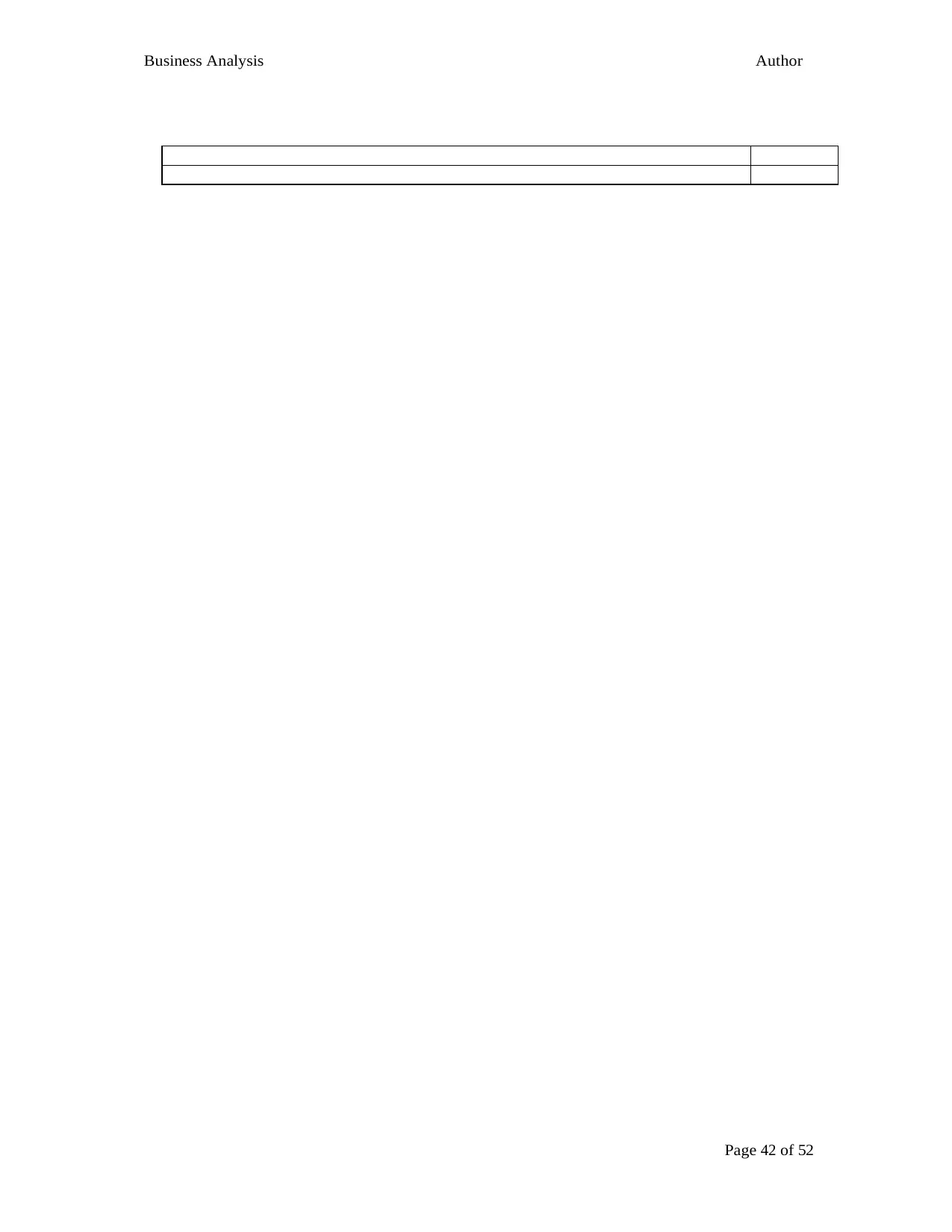
Page 42 of 52
Business Analysis
Report
Author
Business Analysis
Report
Author
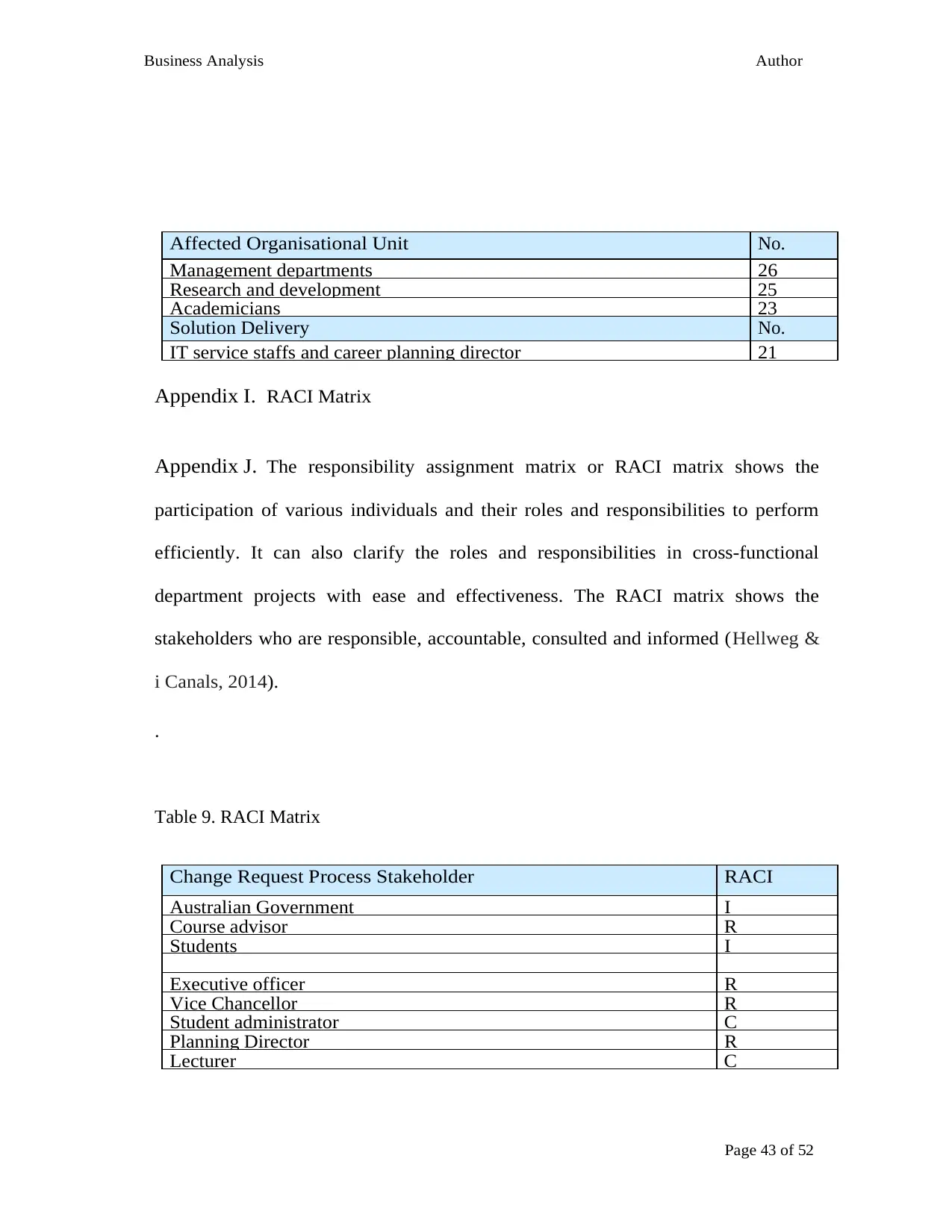
Page 43 of 52
Business Analysis
Report
Author
Affected Organisational Unit No.
Management departments 26
Research and development 25
Academicians 23
Solution Delivery No.
IT service staffs and career planning director 21
Appendix I. RACI Matrix
Appendix J. The responsibility assignment matrix or RACI matrix shows the
participation of various individuals and their roles and responsibilities to perform
efficiently. It can also clarify the roles and responsibilities in cross-functional
department projects with ease and effectiveness. The RACI matrix shows the
stakeholders who are responsible, accountable, consulted and informed (Hellweg &
i Canals, 2014).
.
Table 9. RACI Matrix
Change Request Process Stakeholder RACI
Australian Government I
Course advisor R
Students I
Executive officer R
Vice Chancellor R
Student administrator C
Planning Director R
Lecturer C
Business Analysis
Report
Author
Affected Organisational Unit No.
Management departments 26
Research and development 25
Academicians 23
Solution Delivery No.
IT service staffs and career planning director 21
Appendix I. RACI Matrix
Appendix J. The responsibility assignment matrix or RACI matrix shows the
participation of various individuals and their roles and responsibilities to perform
efficiently. It can also clarify the roles and responsibilities in cross-functional
department projects with ease and effectiveness. The RACI matrix shows the
stakeholders who are responsible, accountable, consulted and informed (Hellweg &
i Canals, 2014).
.
Table 9. RACI Matrix
Change Request Process Stakeholder RACI
Australian Government I
Course advisor R
Students I
Executive officer R
Vice Chancellor R
Student administrator C
Planning Director R
Lecturer C
Secure Best Marks with AI Grader
Need help grading? Try our AI Grader for instant feedback on your assignments.

Page 44 of 52
Business Analysis
Report
Author
Appendix K. Organisational Structure of Specific Department
The organisational structure is the actual framework of organisational structure that
includes the various target departments and portfolios within the departments that
are of interests.
Figure 3. Department xxx Organisational Structure Diagram (SAMPLE ONLY)
Appendix L. The Five Conflict Handling Modes
The communication between stakeholders is essential for ensuring that the system is
implemented properly and all the issues concerned with the learning management
Business Analysis
Report
Author
Appendix K. Organisational Structure of Specific Department
The organisational structure is the actual framework of organisational structure that
includes the various target departments and portfolios within the departments that
are of interests.
Figure 3. Department xxx Organisational Structure Diagram (SAMPLE ONLY)
Appendix L. The Five Conflict Handling Modes
The communication between stakeholders is essential for ensuring that the system is
implemented properly and all the issues concerned with the learning management
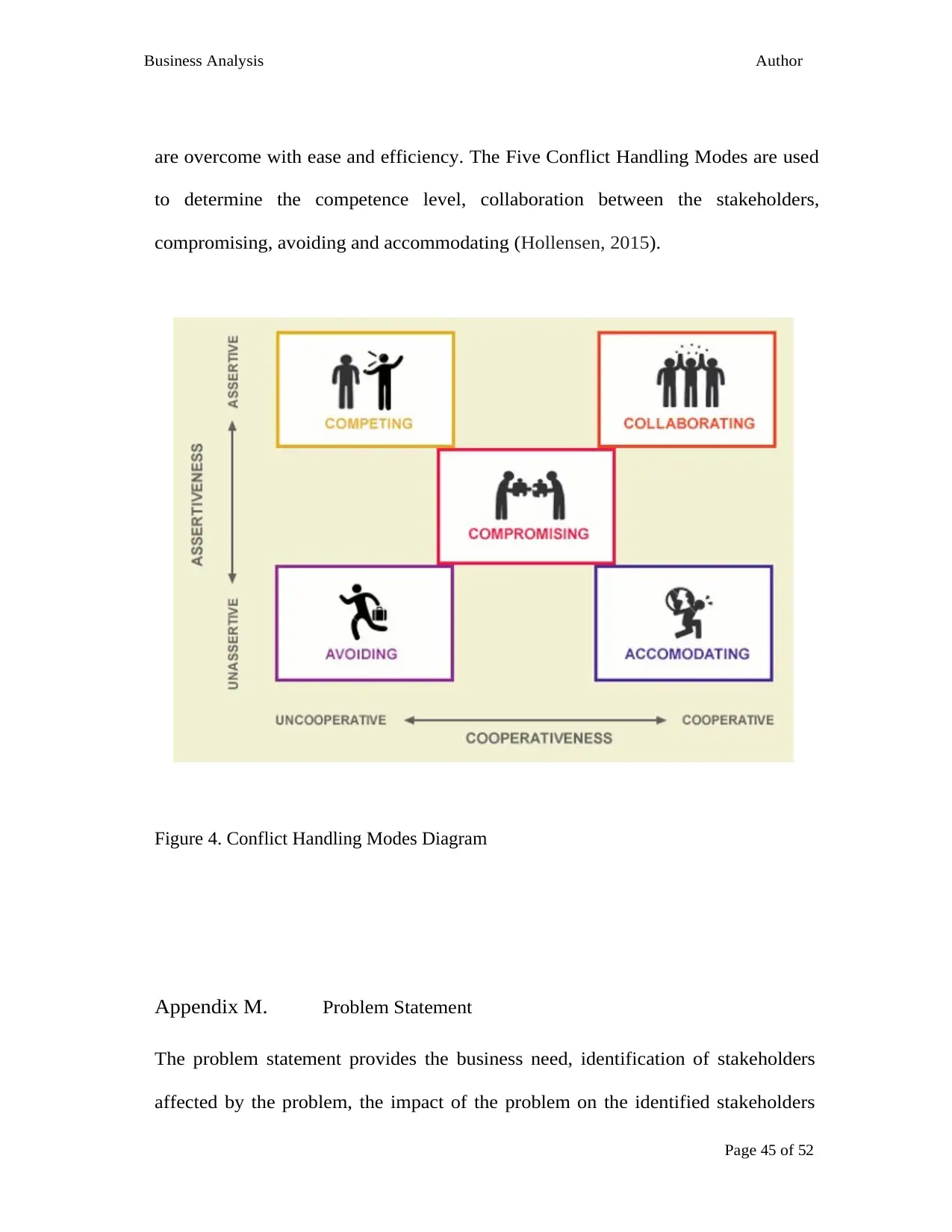
Page 45 of 52
Business Analysis
Report
Author
are overcome with ease and efficiency. The Five Conflict Handling Modes are used
to determine the competence level, collaboration between the stakeholders,
compromising, avoiding and accommodating (Hollensen, 2015).
Figure 4. Conflict Handling Modes Diagram
Appendix M. Problem Statement
The problem statement provides the business need, identification of stakeholders
affected by the problem, the impact of the problem on the identified stakeholders
Business Analysis
Report
Author
are overcome with ease and efficiency. The Five Conflict Handling Modes are used
to determine the competence level, collaboration between the stakeholders,
compromising, avoiding and accommodating (Hollensen, 2015).
Figure 4. Conflict Handling Modes Diagram
Appendix M. Problem Statement
The problem statement provides the business need, identification of stakeholders
affected by the problem, the impact of the problem on the identified stakeholders

Page 46 of 52
Business Analysis
Report
Author
and the benefits of the solution if it was to be implemented.
Table 10. Problem Statement
The problem of Implementation of Human Activity system used for the
Learning management at the Griffith UniversityAffects There are many stakeholders who have been affected
including the students, faculties, academicians, Vice
Chancellor, investors or shareholders who may have not got
The impact
of which is
The students have faced issues to access the right amounts of
data and information. Lack of opportunities for growth and
development, which has resulted in less numbers of
A successful
solution
would
Improve the organisational efficiency by enhancing the
reliability of learning management approaches and
furthermore allow students to access data and
Appendix N. Force Field Analysis
The Force field analysis determines the various factors that have created an impact
on a particular situation during the time issues were faced while implementing the
Human Activity system for learning management at Griffith University.
Strength Force that create impact on change Opposing force Strength
4 4
5
2
9 4
Total= 18 Total= 10
Human Activity
system to learning
management
More flexible
options
Effective
procedures of
enrolment
Both financial and
human resources
used properly
Lesser growth in
courses offered
Inappropriate
infrastructure
Limitations of
meeting criteria
and quality
Business Analysis
Report
Author
and the benefits of the solution if it was to be implemented.
Table 10. Problem Statement
The problem of Implementation of Human Activity system used for the
Learning management at the Griffith UniversityAffects There are many stakeholders who have been affected
including the students, faculties, academicians, Vice
Chancellor, investors or shareholders who may have not got
The impact
of which is
The students have faced issues to access the right amounts of
data and information. Lack of opportunities for growth and
development, which has resulted in less numbers of
A successful
solution
would
Improve the organisational efficiency by enhancing the
reliability of learning management approaches and
furthermore allow students to access data and
Appendix N. Force Field Analysis
The Force field analysis determines the various factors that have created an impact
on a particular situation during the time issues were faced while implementing the
Human Activity system for learning management at Griffith University.
Strength Force that create impact on change Opposing force Strength
4 4
5
2
9 4
Total= 18 Total= 10
Human Activity
system to learning
management
More flexible
options
Effective
procedures of
enrolment
Both financial and
human resources
used properly
Lesser growth in
courses offered
Inappropriate
infrastructure
Limitations of
meeting criteria
and quality
Paraphrase This Document
Need a fresh take? Get an instant paraphrase of this document with our AI Paraphraser
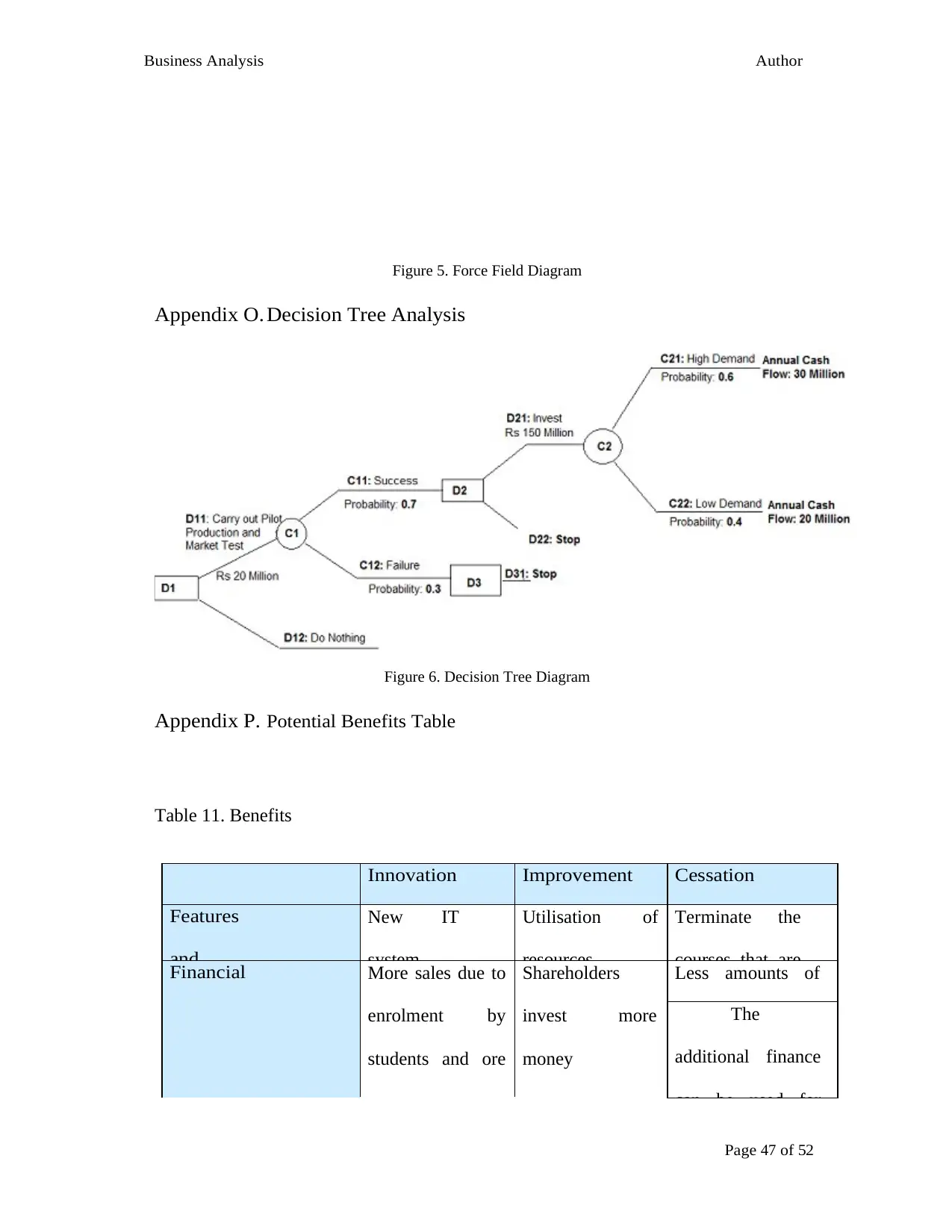
Page 47 of 52
Business Analysis
Report
Author
Figure 5. Force Field Diagram
Appendix O. Decision Tree Analysis
Figure 6. Decision Tree Diagram
Appendix P. Potential Benefits Table
Table 11. Benefits
Innovation Improvement Cessation
Features
and
New IT
system
Utilisation of
resources
Terminate the
courses that are
Financial More sales due to
enrolment by
students and ore
Shareholders
invest more
money
Less amounts of
expensesThe
additional finance
can be used for
Business Analysis
Report
Author
Figure 5. Force Field Diagram
Appendix O. Decision Tree Analysis
Figure 6. Decision Tree Diagram
Appendix P. Potential Benefits Table
Table 11. Benefits
Innovation Improvement Cessation
Features
and
New IT
system
Utilisation of
resources
Terminate the
courses that are
Financial More sales due to
enrolment by
students and ore
Shareholders
invest more
money
Less amounts of
expensesThe
additional finance
can be used for
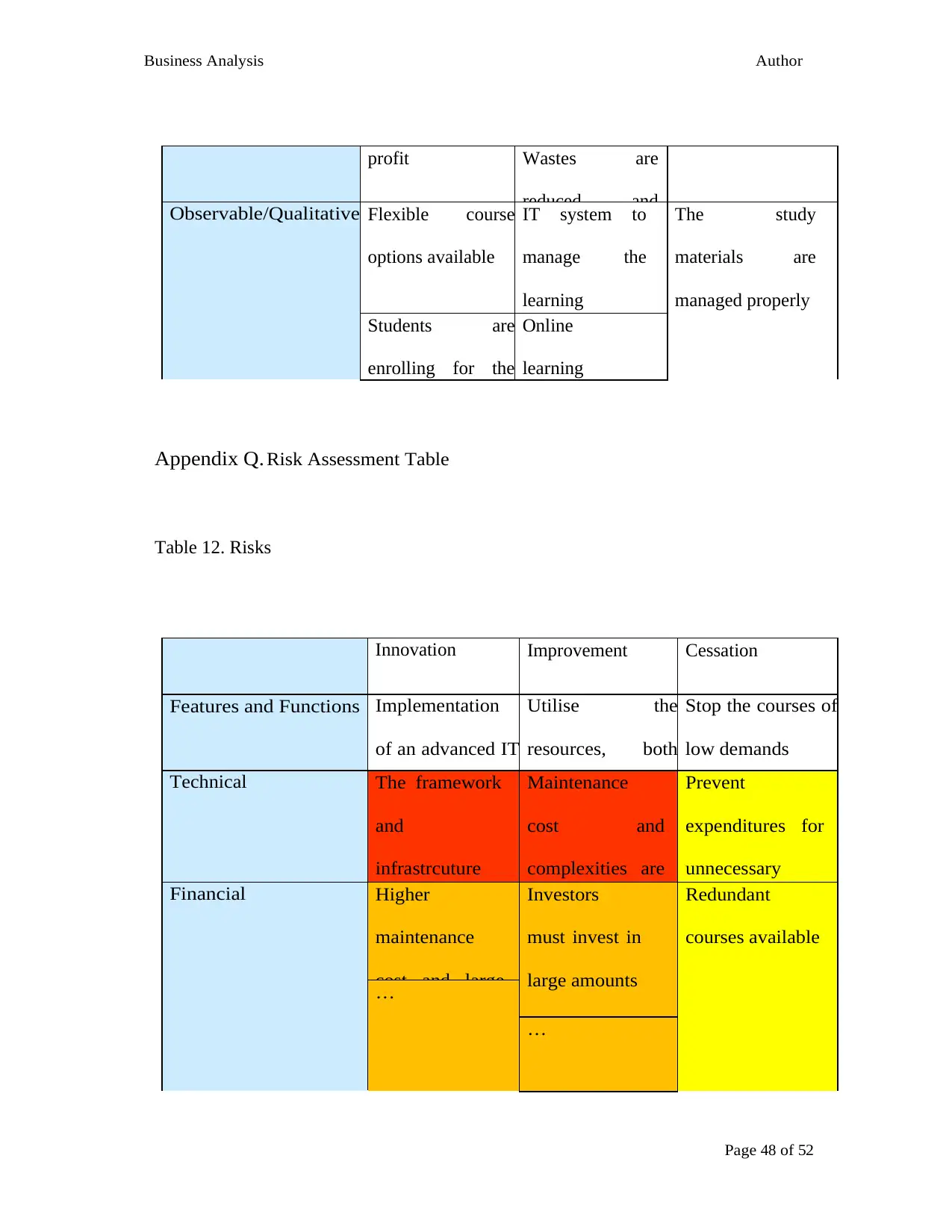
Page 48 of 52
Business Analysis
Report
Author
profit Wastes are
reduced and
Observable/Qualitative Flexible course
options available
IT system to
manage the
learning
approaches
The study
materials are
managed properly
Students are
enrolling for the
courses in more
Online
learning
system is
Appendix Q. Risk Assessment Table
Table 12. Risks
Innovation Improvement Cessation
Features and Functions Implementation
of an advanced IT
system
Utilise the
resources, both
financial and
Stop the courses of
low demands
Technical The framework
and
infrastrcuture
of IT system is
Maintenance
cost and
complexities are
high
Prevent
expenditures for
unnecessary
study materials
Financial Higher
maintenance
cost and large
Investors
must invest in
large amounts
Redundant
courses available
…
…
Business Analysis
Report
Author
profit Wastes are
reduced and
Observable/Qualitative Flexible course
options available
IT system to
manage the
learning
approaches
The study
materials are
managed properly
Students are
enrolling for the
courses in more
Online
learning
system is
Appendix Q. Risk Assessment Table
Table 12. Risks
Innovation Improvement Cessation
Features and Functions Implementation
of an advanced IT
system
Utilise the
resources, both
financial and
Stop the courses of
low demands
Technical The framework
and
infrastrcuture
of IT system is
Maintenance
cost and
complexities are
high
Prevent
expenditures for
unnecessary
study materials
Financial Higher
maintenance
cost and large
Investors
must invest in
large amounts
Redundant
courses available
…
…

Page 49 of 52
Business Analysis
Report
Author
Organisational/
Business Change
Business
processes
restructuring
Skilled workers
and
enhancement of
their
performances
Lack of skills and
knowledge among
..
Appendix R. MoSCoW Analysis
The MoSCoW Analysis helps to analyse the four major areas including the final
solution for managing business success, portion of the implementation solution,
implementation of final solution and desired outcomes that can be expected in the
future.
Figure 7. MoSCoW Analysis
More flexible options for the courses available 1 Must
More enrolment scopes for students to fill the gaps of the
University
2 Must
Increased use of higher education facilities for fulfilling the
demands and preferences
3 Should
More academic courses that are available 4 Should
Business Analysis
Report
Author
Organisational/
Business Change
Business
processes
restructuring
Skilled workers
and
enhancement of
their
performances
Lack of skills and
knowledge among
..
Appendix R. MoSCoW Analysis
The MoSCoW Analysis helps to analyse the four major areas including the final
solution for managing business success, portion of the implementation solution,
implementation of final solution and desired outcomes that can be expected in the
future.
Figure 7. MoSCoW Analysis
More flexible options for the courses available 1 Must
More enrolment scopes for students to fill the gaps of the
University
2 Must
Increased use of higher education facilities for fulfilling the
demands and preferences
3 Should
More academic courses that are available 4 Should
Secure Best Marks with AI Grader
Need help grading? Try our AI Grader for instant feedback on your assignments.
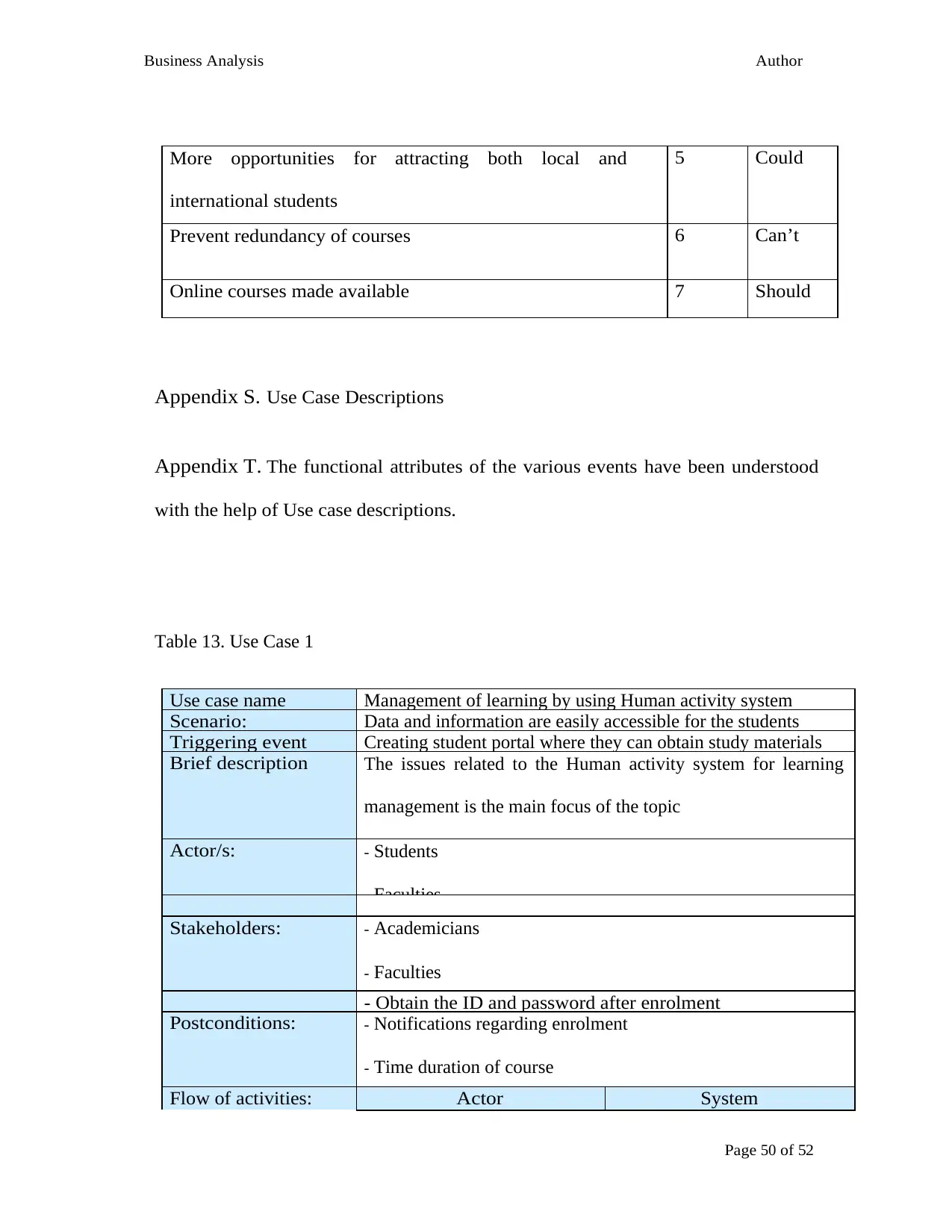
Page 50 of 52
Business Analysis
Report
Author
More opportunities for attracting both local and
international students
5 Could
Prevent redundancy of courses 6 Can’t
Online courses made available 7 Should
Appendix S. Use Case Descriptions
Appendix T. The functional attributes of the various events have been understood
with the help of Use case descriptions.
Table 13. Use Case 1
Use case name Management of learning by using Human activity system
Scenario: Data and information are easily accessible for the students
Triggering event Creating student portal where they can obtain study materials
Brief description The issues related to the Human activity system for learning
management is the main focus of the topic
Actor/s: - Students
- Faculties
Stakeholders: - Academicians
- Faculties
- Obtain the ID and password after enrolment
Postconditions: - Notifications regarding enrolment
- Time duration of course
Flow of activities: Actor System
Business Analysis
Report
Author
More opportunities for attracting both local and
international students
5 Could
Prevent redundancy of courses 6 Can’t
Online courses made available 7 Should
Appendix S. Use Case Descriptions
Appendix T. The functional attributes of the various events have been understood
with the help of Use case descriptions.
Table 13. Use Case 1
Use case name Management of learning by using Human activity system
Scenario: Data and information are easily accessible for the students
Triggering event Creating student portal where they can obtain study materials
Brief description The issues related to the Human activity system for learning
management is the main focus of the topic
Actor/s: - Students
- Faculties
Stakeholders: - Academicians
- Faculties
- Obtain the ID and password after enrolment
Postconditions: - Notifications regarding enrolment
- Time duration of course
Flow of activities: Actor System
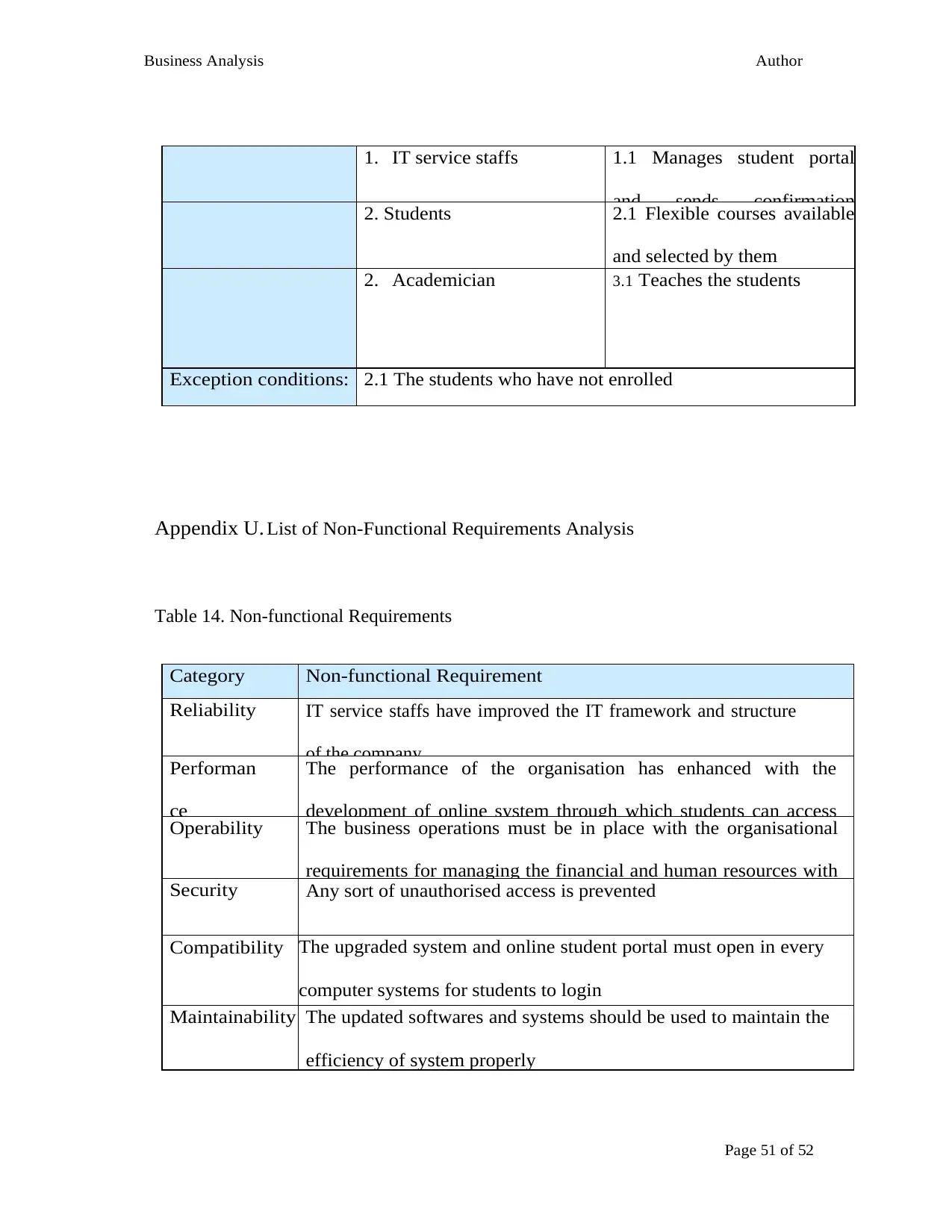
Page 51 of 52
Business Analysis
Report
Author
1. IT service staffs 1.1 Manages student portal
and sends confirmation
2. Students 2.1 Flexible courses available
and selected by them
2. Academician 3.1 Teaches the students
Exception conditions: 2.1 The students who have not enrolled
Appendix U. List of Non-Functional Requirements Analysis
Table 14. Non-functional Requirements
Category Non-functional Requirement
Reliability IT service staffs have improved the IT framework and structure
of the company
Performan
ce
The performance of the organisation has enhanced with the
development of online system through which students can access
Operability The business operations must be in place with the organisational
requirements for managing the financial and human resources with
Security Any sort of unauthorised access is prevented
Compatibility The upgraded system and online student portal must open in every
computer systems for students to login
Maintainability The updated softwares and systems should be used to maintain the
efficiency of system properly
Business Analysis
Report
Author
1. IT service staffs 1.1 Manages student portal
and sends confirmation
2. Students 2.1 Flexible courses available
and selected by them
2. Academician 3.1 Teaches the students
Exception conditions: 2.1 The students who have not enrolled
Appendix U. List of Non-Functional Requirements Analysis
Table 14. Non-functional Requirements
Category Non-functional Requirement
Reliability IT service staffs have improved the IT framework and structure
of the company
Performan
ce
The performance of the organisation has enhanced with the
development of online system through which students can access
Operability The business operations must be in place with the organisational
requirements for managing the financial and human resources with
Security Any sort of unauthorised access is prevented
Compatibility The upgraded system and online student portal must open in every
computer systems for students to login
Maintainability The updated softwares and systems should be used to maintain the
efficiency of system properly
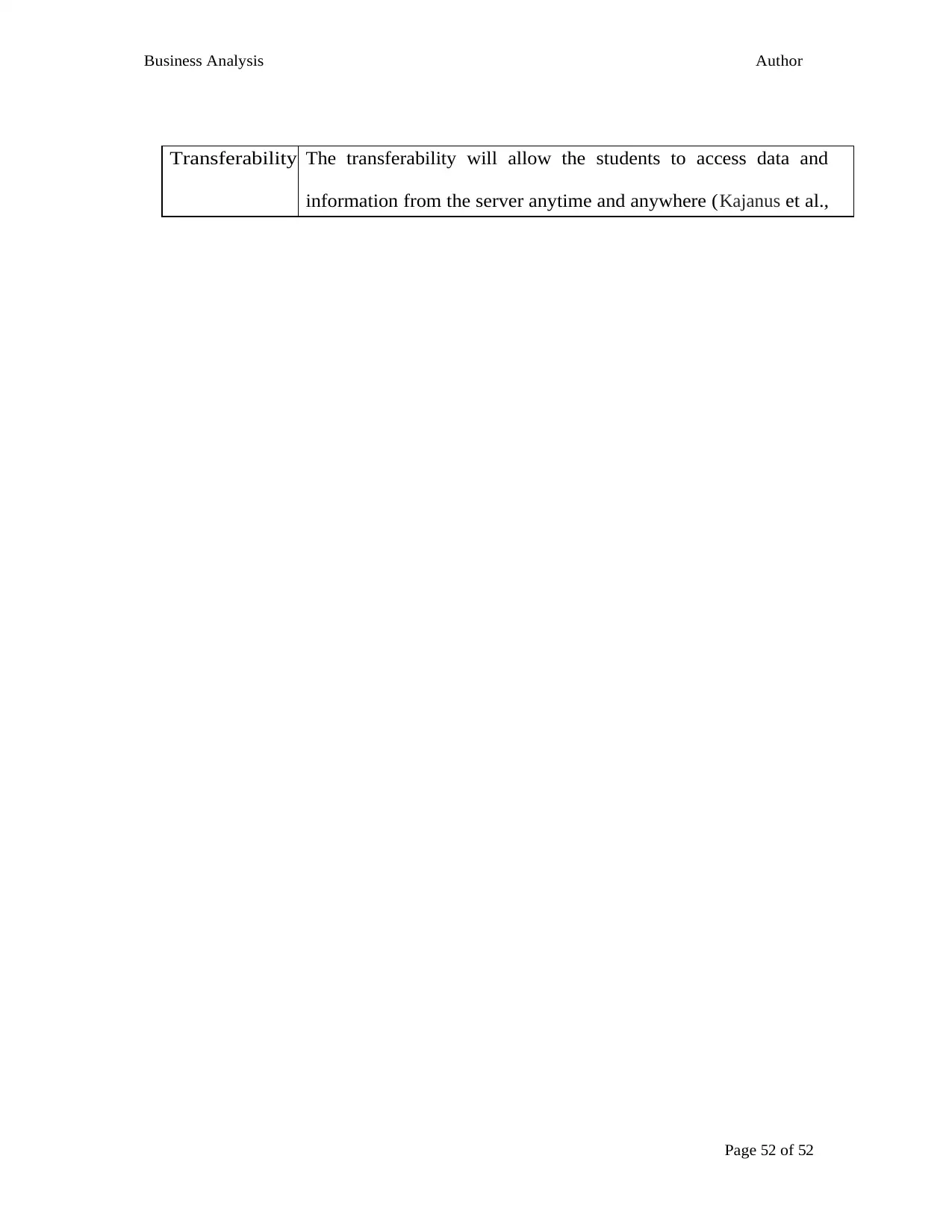
Page 52 of 52
Business Analysis
Report
Author
Transferability The transferability will allow the students to access data and
information from the server anytime and anywhere (Kajanus et al.,
2012).
Business Analysis
Report
Author
Transferability The transferability will allow the students to access data and
information from the server anytime and anywhere (Kajanus et al.,
2012).
1 out of 55
Related Documents
Your All-in-One AI-Powered Toolkit for Academic Success.
+13062052269
info@desklib.com
Available 24*7 on WhatsApp / Email
![[object Object]](/_next/static/media/star-bottom.7253800d.svg)
Unlock your academic potential
© 2024 | Zucol Services PVT LTD | All rights reserved.





